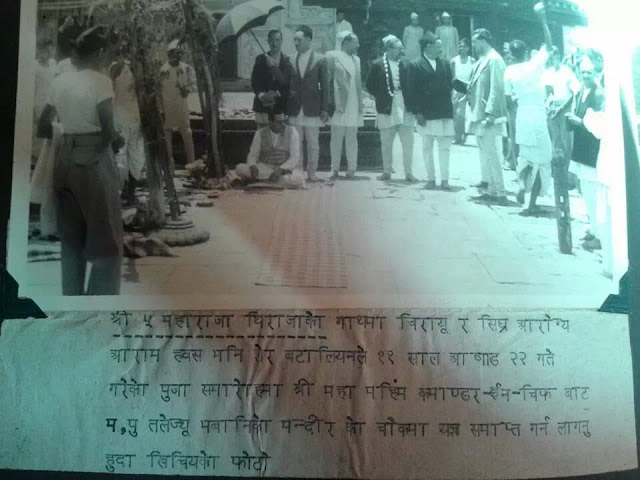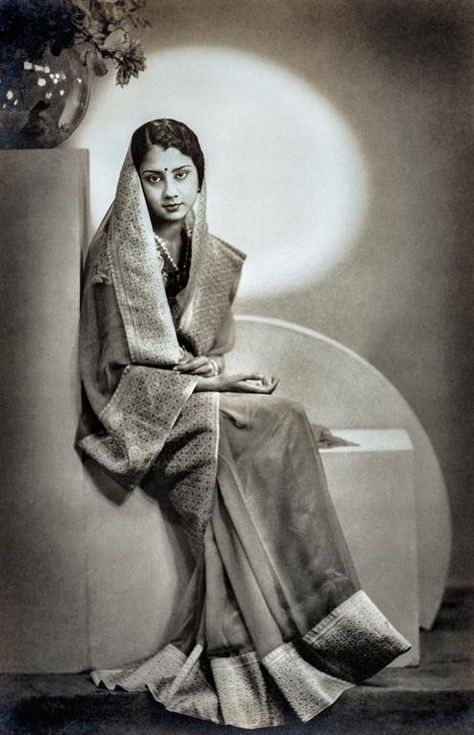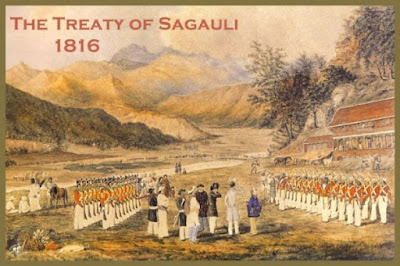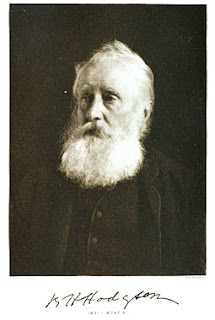
Posts by RanaSubodh:
DECLARATION OF INDEPENDENCE
April 19th, 2019The Declaration of Independence world is familiar with is that of a nascent United States of America freeing itself from the colonial masters and taking the destiny of its new nation in its own firm hands. We in Nepal always take it for granted that we were never colonized by the British which left us poorer perhaps due to isolation but prouder as a sovereign nation. It was not always so and had the twists and turns of late 19th Century diplomacy not gone our way; we might have been a part of Independent India today. So, when and how did we actually declare ourselves independent from the Raj, the British rule in the Indian Subcontinent?
| Map showing Nepal before the Treaty of Sugauly |
The prelude to this important moment in our nation’s history started with the Rana prime minister Jung Bahadur Rana cleverly positioning himself as a friend and ally of the British. History had already taught him how his foolish grand-uncle Bhimsen Thapa the prime minister of an ever expanding Gurkhali nation had locked horns with the East India Company. The Anglo-Nepal War of 1814-16 had ended in a humiliating defeat where not only egos were bruised but large chunks of Nepalese territory had to be ceded to the Raj under the Treaty of Sugauly. Jung Bhadaur Rana was not going to repeat this sad state of affairs. He would befriend the British and prove his loyalty.
The grand prize he received from the British was the trail-blazing invitation to visit England as ambassador extraordinary and plenipotentiary of the Kingdom of Nepal in 1850 A.D., decades before any of the rulers of the Indian States were to be thus invited. Jung capitalized on this opportunity and further enhanced his relationship with both the British royalty as well as the directors of the East India Company. In 1857 A.D. he cleverly allied himself with the hard-pressed British forces against the rebellion in India and went personally to defeat the armies of the rebellious nation of Oudh (Awadh) in Lucknow. The British rewarded him with the return of some of the lost territories. He was also awarded the tile of Maharajah of Kaski and Lamjung by the Nepalese king. His rule was now secure.
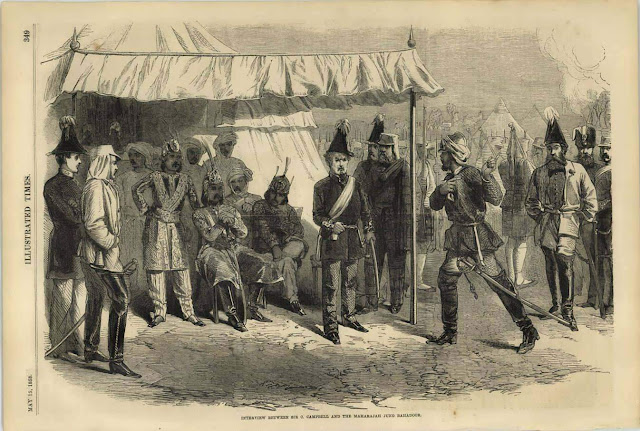 |
| Jung Bahadur Rana with Colin Campbell, Commander-in- Chief of British forces, in Lucknow during Mutiny |
Big Game Hunting was an important domain in the wooing of British Royalty and Viceroys of India. Plentiful games in the Nepal Terai meant that the rulers enamoured with the sport of hunting made a bee-line to visit Nepal. Unrolling the proverbial red carpet, the Rana rulers regaled the hunters in the Terai, but strictly made sure they would not visit Kathmandu Valley. They never handed over to the British the keys to the kingdom. After the death of Jung Bahadur Rana his successors took to heart the lessons taught by Jung and continued the tradition of organizing for the British royals lavish hunting expeditions in the Nepal Terai.
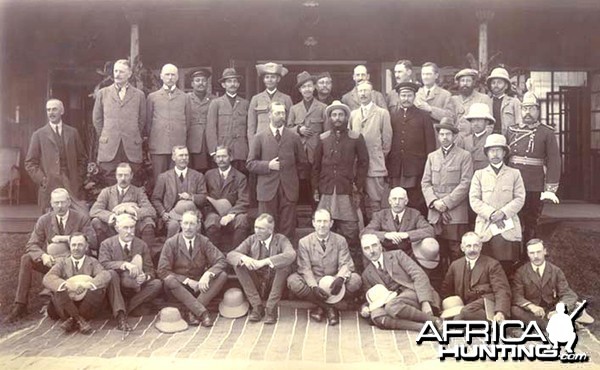 |
| King George V in hunting expedition in Nepal Terai with Maharajah Chandra |
Maharajah Sir Chandra Shumsher J. B. Rana was the shrewdest of the Rana prime ministers and it is to his credit that we have got an independent Nepal today. Viceroy Lord Curzon had expressed his desire to hunt tigers in Nepal Terai during the tenure of Maharajah Bir Shumsher but due to his failing health the actual hunt was organized by Maharajah Dev Shumsher soon after the death of Bir and delegated his second in command Major General Chandra Shumsher to actually host the viceroy. The bond established between Curzon and Chandra led to Chandra’s getting an invitation to attend the Coronation Durbar held in Delhi organized by the viceroy to mark the accession of King Edward VII to the British throne in 1903 A.D. Chandra had positioned himself brilliantly once again as a friend of the British just like his uncle Jung Bahadur had done. He received a personal 19-gun salute there as the prime minister of Nepal.
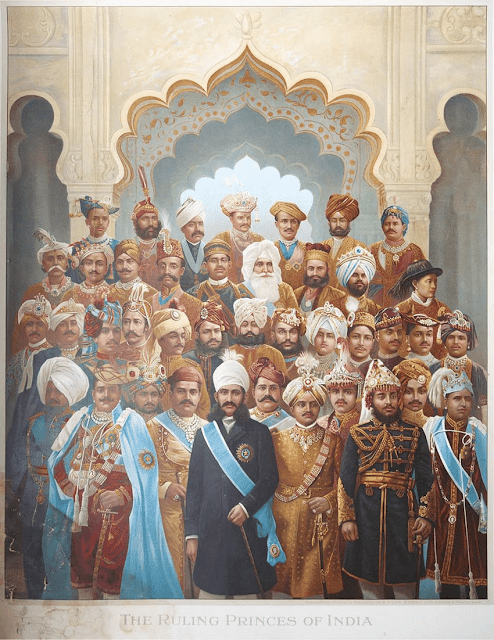 |
| Delhi Durbar of 1903 A.D. Maharajah Chandra (second from right) with rulers of Princely States |
In 1908 A.D. Maharajah Chandra Shumsher became the second prime minister of Nepal to be invited to visit Britain after Jung Bahadur Rana. Although his visit has not been as storied as that of his illustrious uncle, the diplomatic exchanges made Nepal ever more an indispensable ally of the British in Asia. King Edward VII gave him a private audience and awarded him the Order of the Knight Grand Cross of the Bath. Chandra would henceforth be addressed as “Sir”. He had meetings with Prime Minister Herbert Henry Asquith. He was awarded an honorary degree by Oxford University at its Ancaenia, a ceremonial high-point of its academic year, an approbation that even alluded King Mahendra later during his state visit, much to his chagrin.
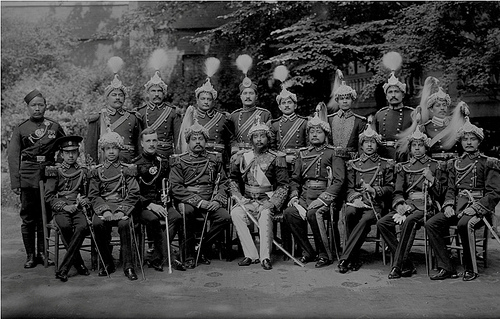 |
| Maharajah Chandra at Mortimer House, London, flanked by Juddha his brother (R) and Rudra his nephew (L) |
Chandra had another opportunity to attend the Delhi Durbar organized by Viceroy Charles Hardinge to commemorate the accession of King George V. This time the new king and his queen Mary would be attending the celebrations at Delhi in December of 1911. Following the celebrations Chandra hosted a hunting expedition for King George V in the Nepal Terai.
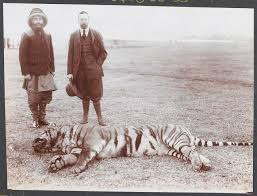 |
| Chandra with King George V |
The year was 1923 A.D. Chandra was basking in his laurels now. The British were going to sign a Treaty of Friendship with Nepal. The draft treaty came from Calcutta. Chandra was the first Rana ruler to matriculate and he did read and speak English. However, in matters of such gravity he needed a few courtiers to consult. Ram Mani Acharya Dixit, son of Shiromani Dixit, was the mandarin wielding power and commanding respect due to his proximity to Chandra. His father Shiromani had served the Shumsher clan with distinction as he was the tutor to the children of Commander-in-Chief Dhir Shumsher Jung Bahadur Rana, father of Chandra. During the premiership of Maharajah Bir Shumsher, Shiromani had performed many religious rites including the momentous yagya called Agnistone Hom at Kashi, today’s Varanasi.
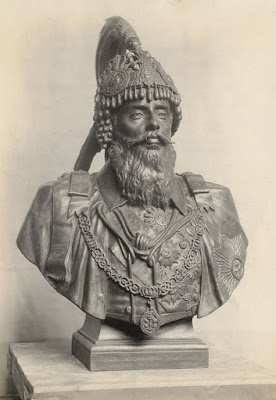 |
| Bust of Maharajah Chandra by Tonelli |
Chandra was now frowning at the draft document, stroking his salt and pepper beard that cascaded down to his chest, his piercing eyes burning into the parchment in concentration since he knew he could not afford to make any mistake on this treaty. His adviser Ram Mani had urged him to not concede on certain demands, to delete certain paragraphs and send the draft back to Calcutta. He smiled. Chandra remembered how his uncle Jung Bahadur liked to toy with the British and have his way at the end. Chandra was only 13 years old when Jung passed away but he did remember the resoluteness of the wily old ruler. Chandra nodded at Ram Mani in agreement and ordered him to send back the draft with the necessary changes made. The British concurred. Nepal had acquired its independence. Ages later people would remember that Treaty as the reason why Nepal was not absorbed into Independent India by the likes of Sardar Vallabhbhai Patel, the bane of the Indian princely states!
Comments Off on DECLARATION OF INDEPENDENCE
THE CROWNING GLORY
November 2nd, 2018In Nepal too we had Coronation celebrations of King Mahendra in 1956 A.D. and of King Birendra in 1975 A.D. Representatives of 15 nations Nepal had established diplomatic relations with attended the coronation ceremony of King Mahendra. The international media came to Shangri-La in a frenzy to cover the virtually unknown country. By the time of King Birendra’s Coronation Nepal was a truly established nation introduced to the world as a haven for the Hippy culture and backpackers exploring the high Himalaya. Nepal had established diplomatic relations with 60 nations and many of their representatives came to attend the ceremony including Britain’s Prince Charles and Earl Mountbatten and the notorious First Lady of the Philippines Imelda Marcos.
What is less known today is the Coronation ceremonies for the Rana prime ministers of Nepal who inherited together with the high post the title of Maharajah of Kaski and Lamjung. Thus they orchestrated grand “Sindoor Jatra” or Vermilion Festival and went around Kathmandu city in triumphal procession on elaborately caparisoned tusker elephants and accepted tribute from cheering crowds. Denizens of Kathmandu like a “ramita” or a show and irrespective of political leanings everybody has fun whether cheering a Shah king or a Rana maharajah, an elected politician or a recalcitrant Maoist. Why not indeed as a Jatra is a Jatra and merrymaking is in our genes!
 |
| First Rana prime minister Maharajah Jung Bahadur Rana and his 6 brothers |
The following collection of photographs show the Rana Maharajahs participating in elaborate coronation ceremonies. I wanted to collect these old photographs and save it in one place for the history buffs. As Shakespeare wrote in King Henry IV, “uneasy lies the head that wears the crown”. The Rana regime is history.
 |
| The first Maharajah of the Shumsher clan Bir Shumsher during investiture ceremony |
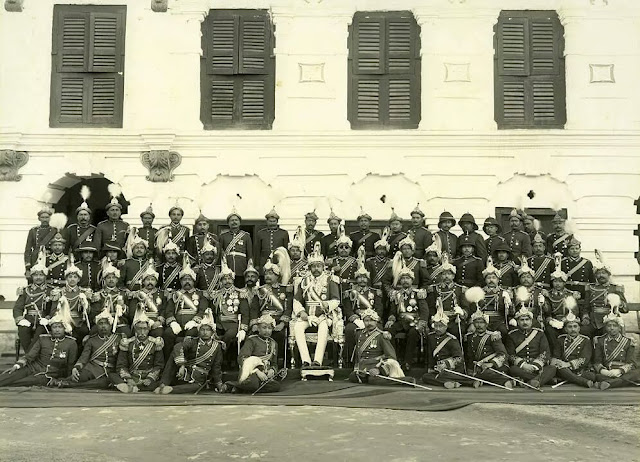 |
| Maharajah Juddha Shumsher sitting on his coronation throne |
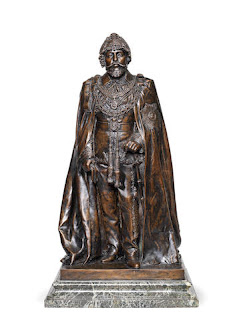 |
| Statue of Maharajah Chandra |
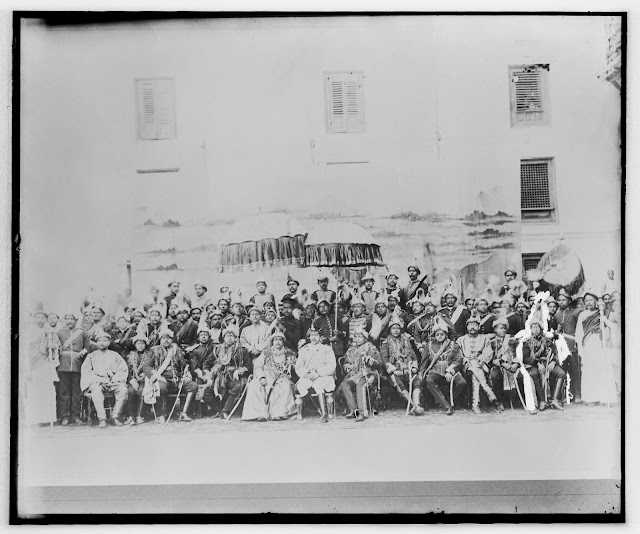 |
| Maharajah Dev Shumsher in coronation robe with King Prithivi Bir Bikram Shah in white military uniform |
 |
| Maharajah Padma Shumsher with King Tribhuvan Bir Bikram Shah and his sons |
 |
| Last Rana prime minister Maharajah Mohan Shumsher |
Comments Off on THE CROWNING GLORY
COURT INTRIGUES OF THE THREE SISTERS
October 5th, 2018
Recently Bagh Durbar located near the erstwhile Bhimsen Tower ‘Dharahara’ at the heart of Kathmandu city was in the news as the Municipality had more or less decided to demolish a historical building adversely affected by the earthquake of 2015 instead of renovating and retrofitting it. Many have raised their voices against such a historical place being leveled to give rise to yet another shopping mall without the valley’s soul. It would be another example of a potpourri of architectural styles prevalent in the unimpressive designs adorning Kathmandu’s march to modernity. Mrs. Chanda Rana is one of the advocates of preservation of this historic building and kudos to her.
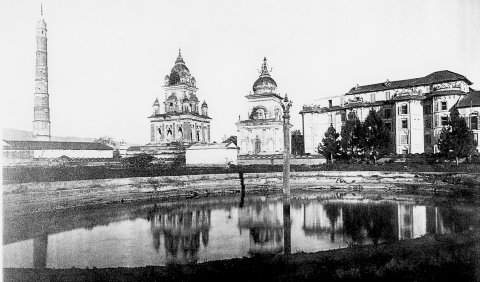
What is the genesis of this historic building? What cries and whispers pervaded its corridors when the powerful were residing there? What were the historical epoch its bricks and mortars witnessed that would shape the destiny of the movers and shakers of the nation? Will all this be lost forever in the drive to demolish it and for the politicians and contractors to reap a rich reward in commissions and bribes?
Bhimsen Thapa Chapter: Bhimsen Thapa, Prime Minister of Nepal, 1806-1837 A.D.
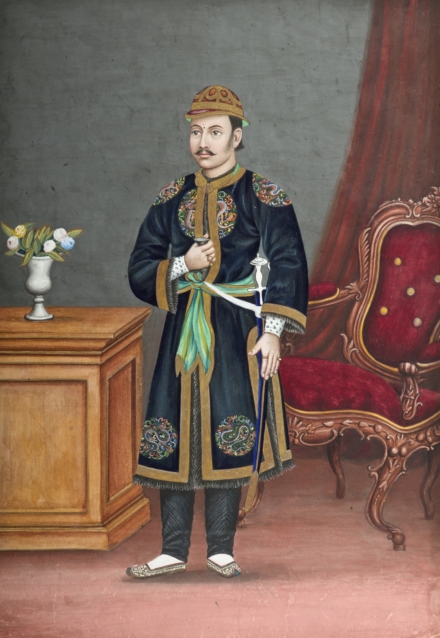
Prime Minister Bhimsen Thapa
Prime Minister Bhimsen Thapa is credited to have built the Bagh Durbar along the Mughal-style architecture prevalent in palaces of India before the British inevitably brought their own neo-classical designs of Europe. He inherited the grounds from his father Amar Singh Thapa and moved in there in 1805 A.D. from Thapathali Durbar, the ancestral abode of the Thapa clan. Bagh Durbar or the Garden Palace was the abode of the prime minister for a very long time as he ruled Nepal for 32 eventful years. The urban legend of the building being named after real tigers being kept at its gate – as ‘bagh’ in Nepali language is tiger – made it a forbidden location for the general populace to venture without sufficient good reason. We can clearly see Bhimsen strategizing his war against British India from this edifice. We can visualize him holding countless parleys with his many generals of an expanding Gorkha Empire. He also spent many sleepless nights there when the proud Gorkhali army had to accede to British military pressure and sign the Treaty of Sugauly that stymied Gorkha expansion once and for all. And then finally he was plucked from his palace and jailed when time and tide of Durbari politics went against him after the death of Regent Queen Tripura Sundari and the coming of age of young King Rajendra Bikram Shah.
General Mathabar Singh Thapa Chapter: Prime Minister of Nepal, 1843 – 1845 A.D., nephew of Bhimsen Thapa
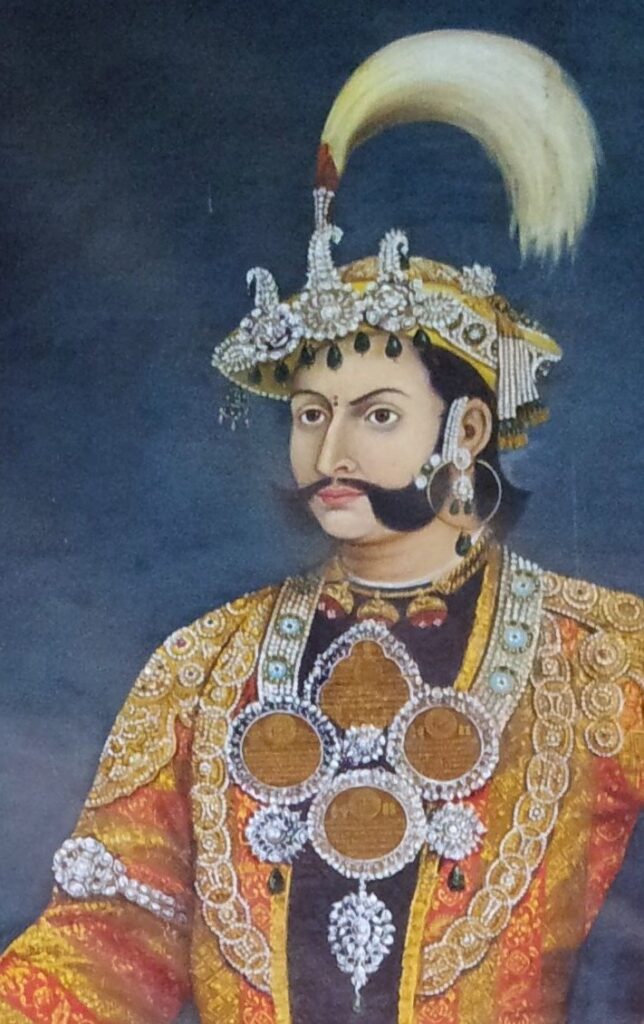
Prime Minister Mathabar Singh Thapa
With the fall of General Bhimsen Thapa the building went to the government until Junior Queen Rajya Luxmi Devi brought back Bhimsen’s nephew General Mathabar Singh Thapa from exile in the Punjab to lead her government. Mathabar claimed Bagh Durbar now through his Thapa lineage and resided there during his short tenure as prime minister of Nepal. After the assassination of Mathabar and the Kot Massacre the building once more went to the government.
Mahila Shebjiu (Duke) Upendra Bikram Shah Chapter: younger brother of King Surendra Bikram Shah, renowned Tantric master, father of Prince Dhirendra
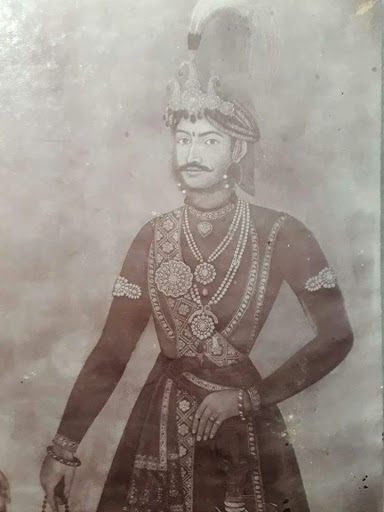
However in 1854 A.D. Prime Minister Jung Bahadur Rana renovated it and made it the official residence of Prince Upendra Bikram Shah, the younger brother of King Surendra Bikram Shah, after the former was implicated in a plot to unseat both Surendra and Jung Bahadur. No doubt Jung thought it prudent for Upendra to live away from the Hanuman Dhoka Royal Palace under virtual house-arrest so that he did not create more mischief.
After Prime Minister Jung Bahadur Rana’s passing Nepalese politics soon went into overdrive with the contending power centers of Jung’s sons and his younger brothers vying one against the other in consolidating state power. This is where once again Bagh Durbar comes into prominence in deciding who would win the game of thrones. This is when the three sisters, daughters of Jung Bahadur Rana, play their petticoat politics in ironically bringing down the house of Maharajah Jung Bahadur Rana itself. Nepalese historians have given them the names “Utpat”, “Bitpat” and “Mahapat” denoting ascending grades of disaster for their role in political conspiracies of the time.
Maharajah Jung Bahadur Rana willed the title of Maharajah of Kaski and Lumjung to his eldest son General Jagat Jung following the law of primogeniture while the prime-ministership of Nepal would go to his younger brothers in succession of seniority. General Ranauddip Singh became prime minister after Jung’s death but he was also given the title of Maharajah by King Surendra Bikram Shah in contravention to Jung’s will. A furious Jagat Jung was biding his time to get even. Jagat Jung was married to a royal princess, eldest daughter of King Surendra. He was both rich and powerful. But Jung Bahadur had remarried after Jagat Jung’s mother passed away and his Maharani Hiranya Garva Kumari had given birth to two daughters. When they came of age they were given in marriage to the royal princes. Jung’s eldest daughter Tara Rajya Luxmi was the sister of Jagat and Jung’s. The eldest daughter from Maharani Hiranya Garva was Lalita Rajya Luxmi. They were both married to Crown Prince Trailokya Bikram Shah, the Wali A’had, an Arabic title for heir apparent. It was Lalita who produced the heir to Nepal’s throne, Prithvi Bir Bikram Shah. After the untimely death of Trailokya, the infant Prithvi became the Crown Prince of Nepal.
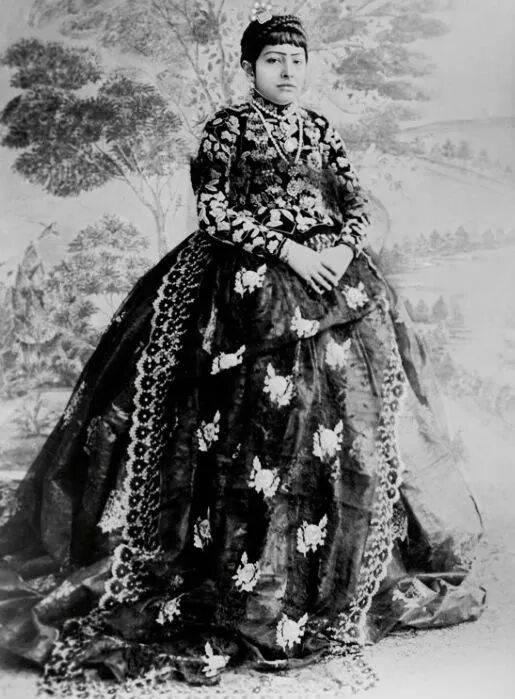
The Three Sisters Chapter: Daughters of Maharajah Jung Bahadur Rana, elder married to Crown Prince Trailokya, and the other two married to Prince Dhirendra
Maharajah Jung Bahadur’s other daughters namely “Chirbiray Maiya” Khadga Kumari, daughter from the Basnet wife Maharani Siddhi Gajendra Luxmi and “Kanchi Maiya” Deep Rajya Luxmi, younger daughter from Maharani Hiranya Garva Kumari were given in marriage to Prince Dhirendra Bikram Shah, the son of Mahila Sahebjiu Upendra and started living in Bagh Durbar. Bir, eldest son of Jung’s youngest brother Dhir Shumsher, was adopted by Jung and his Putali Maharani and hence Jung married him to the daughter of Sahebjiu Upendra, Princess Munindra Dibeshwori, elder sister of Dhirendra. Bir too started residing at Bagh because he simply had nowhere to go. This is where the plot thickens. Daughters of Maharani Hiranya Garva Kumari were dead set against state power going into the hands of their half-brother General Jagat Jung. They would rather have the sons of Dhir Shumsher take power in a coup d’etat and banish their half-brothers.
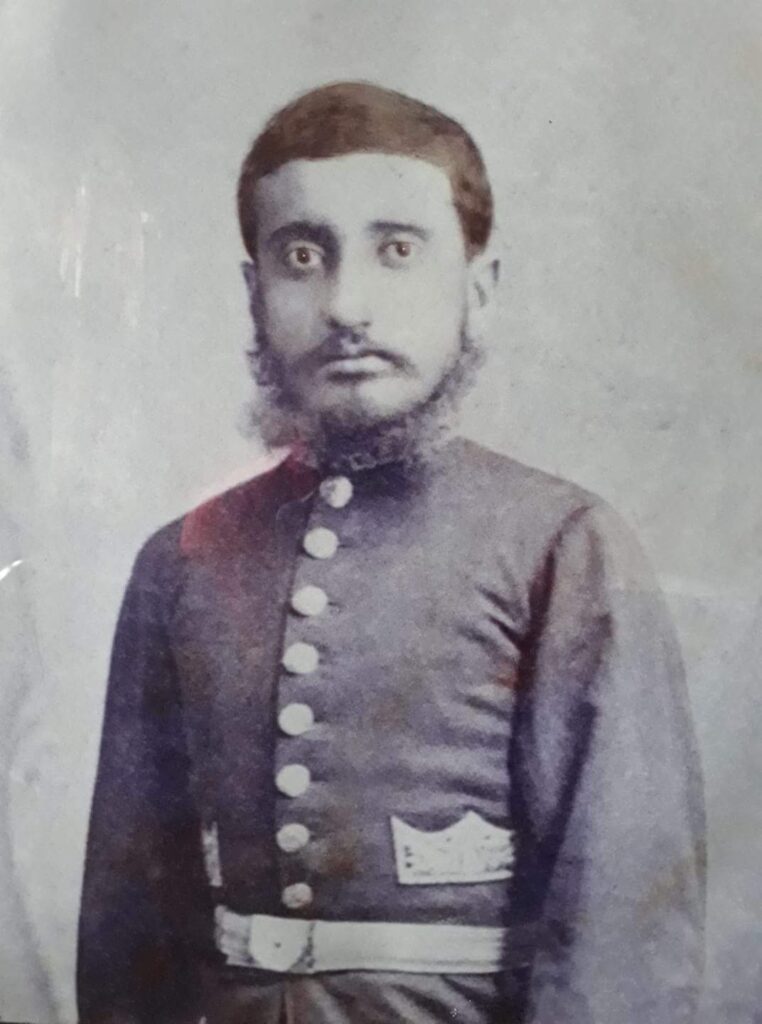
Prince Dhirendra Bikram Shah
King Surendra Bikram Shah died on 17th May 1881 A.D. and the crown went to his grandson the infant Prithvi Bir Bikram and his mother Lalita Rajeshwori was declared the Queen Regent of Nepal. Lalita “Utpat”, Khadga “Bitpat” and Deep “Mahapat” would soon swing into action.
On that fateful November night of 1885 A.D. Prime Minister Ranauddip Singh was assassinated at his Narayanhiti Palace and at the first light of the new day General Bir Shumsher had been sworn in as Maharajah of Kaski and Lamjung and Prime Minister of Nepal by the baby King Prithvi Bir Bikram carried on the arms of his mother Regent Queen Mother Lalita Rajya Luxmi Devi amidst an investiture ceremony held at Tundikhel Parade Ground.
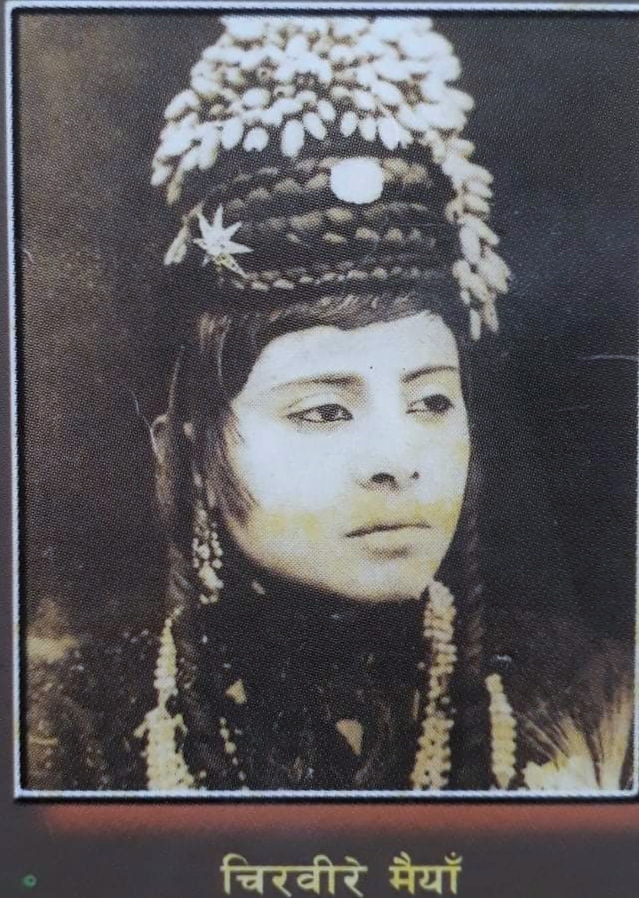
Chirbiray Maiya, Khadga Kumari, first wife of Dhirendra Bikram
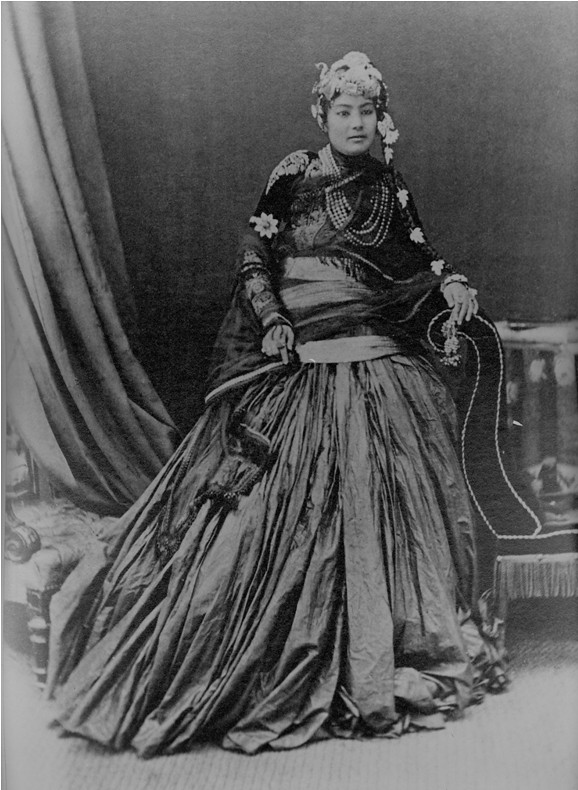
Baghki Kanchi Maiya, Deep Kumari, second wife of Prince Dhirendra Bikram
Epilogue
Would it not be a wonderful idea to have Bagh Durbar in its olden majesty made into a museum dedicated to the lives and times of General Bhimsen Thapa and Mahila Sahebjiu the tantric Upendra Bikram Shah? Last summer I visited Hampton Court Palace near London, the residence of King Henry VIII. Why don’t we turn Bagh Durbar into our own Hampton Court?
Comments Off on COURT INTRIGUES OF THE THREE SISTERS
THE RANI FROM RUKUM
July 14th, 2018Rukum is a scenic hill district of western Nepal where one of the Chaubisi Rajyas or 24 small fiefdoms held sway before unification. Ruled by the Thakuris or the heads of the local clans it was finally absorbed into unified Nepal sometime during the rule of Regent Bahadur Shah. Since then it has been a common practice in the Shah and Rana courts bringing the Thakuri girls from faraway places such as Rukum for an upbringing in the royal households, educating them in palace etiquette, teaching them the culinary arts and instilling in them the love of music and poetry for the purpose of eventually marrying them to the young princes of the house. The girls left their homes and their parents early and made a new life among their peers and minders in the Durbars of Kathmandu. This was the tradition of Dola Palne.
 |
| Thapathai Durbar of Maharajah Jung Bahadur Rana circa 1852 A.D. |
This young girl of six or seven from Rukum who was brought to Kathmandu was taken to the Thapathali Durbar of Jung Bahadur Rana, prime minister and paramount ruler of Nepal then. It was a great privilege for the parents of the little girl to have their offspring selected as one of the Dola to be given in matrimony to her future prince charming. Her future would be bright now as her life in poor hilly Rukum would have meant lack of opportunity and eventual drudgery, even in the higher strata of local society. Her good karma or fate had been sealed and she was named Karma Kumari.
Jung Bahadur Kunwar Ranaji and his seven brothers were ruling the roost then. He as prime minister and his younger brothers headed in various capacities both the military and civil administration of the land. His youngest brother Dhir Shumsher Rana was Jung’s favorite and he used to call him sano nani with affection. Jung had taken state power in a coup de’tat under the blessing of the Junior Queen of Nepal, Rajya Luxmi Devi in 1846 A.D. in the now infamous Kot Parba. Jung and his brothers amassed a fortune subsequently in land revenues, Gurkha repatriation from the British Raj in India and his clever policy of ingratiating himself with the British rulers that reached its zenith in the Lucknow loot. However, Dhir Shumsher as the youngest brother did not have much wealth when he started raising his very large family. Dhir’s first wedded wife had died at childbirth leaving him a healthy baby boy and his eldest brother Jung had taken pity and Jung’s favorite mistress Putali Maharani had adopted him and raised him as her own. The baby was named Narbir Jung. The baby would grow up to become famous in Nepalese history as Bir Shumsher, Maharajah and Prime Minister of Nepal 1886 – 1901 A.D.
Dhir remarried and started to raise a family. The girl from Rukum Karma was raised in Dhir’s household in the Thapathali Durbar Complex. Roll of the cosmic dice would make her a future spouse of Dhir’s second boy Dev Shumsher. Born in 1862 A.D. Dev was adopted by his rich uncle General Krishna Bahadur Kunwar Ranaji. After he came of age Dev married Karma Kumari Devi the dola and childhood friend around 1875 A.D. Dev and Karma both led a very charmed and luxurious life far removed from the penury of his own siblings as his biological father Dhir was still struggling to make ends meet. Karma Kumari was kind-hearted and generous. He raised her own family in Thapathali Durbar and took care of them well as her husband was busy doing military duty in different parts of the country. A few years later Maharajah Jung Bahadur Rana passed away and the prime minister’s post went to his 5th surviving brother Ranoddip Singh Ranaji.
 |
| Dev Shumsher with Karma Kumari and family |
The fissures in the Rana family started to grow. On the one hand were the powerful scions of Maharajah Jung’s family, with untold wealth and Royal connections through marriage. On the other was the family of General Dhir Shumsher, Commander-in-Chief of the Nepalese army and the confident strongman fortressing the reticent nature of his brother the prime minister Ranoddip. Dev and Karma Kumari were caught in between the proverbial rock and hard place. Dev belonged to Dhir’s family but was closer to Jung’s due to his adoption. At this time Dhir Shumsher passed away leaving behind his vulnerable family to the scheming of the Jung family and, worse still, with a few of his sons at a very young age. His youngest wife was Rani Juhar Kumari and from her a son Juddha was born. Karma worried about his plight and what would happen to him in the absence of his father and in the care of a young widow without much means. She decided to look after Juddha and her mother. Karma knew how her husband had the good fortune of being cared for by the Rani of Krishna Bahadur Ranaji and Dev’s elder half-brother Bir Shumsher by Putali Maharani of Maharajah Jung Bahadur. This was her chance to pay back to the Gods for the benevolence shown to her dear husband.
 |
| Rani Karma Kumari |
Karma Kumari was convinced that more political space needed to be given to the common people. In Japan the Meiji Restoration had stripped the ruling Shoguns of power and the Emperor was restored to rule. In India following political dissent the British were on the verge of allowing the registration of the Indian National Congress Party which was eventually founded in 1885 A.D. Serfdom had been abolished in Russia by Tsar Alexander II in 1861 A.D. Karma Kumari had her ears close to the ground as she dealt with people from many walks of life that her husband was not privy to. She used to openly discuss the issues of bonded labour and free education to the masses with her husband and try to convince him to help bring about political reforms by talking to his cousins, sons of Jung Bahadur Rana. From her own resources she provided shelter and drinking water to weary travellers on the Thangkot to Amlekhganj trail. Karma was compassionate and Dev a bon vivant and his motto was ‘Live and Let Live’. They were a good match.
There is a universal truism about the good being the first to go. Nepal in the 1880’s was still a backward place in terms of medical care and there were any number of diseases that swiftly brought about the one inescapable fate – death. Karma Kumari passed away in her early twenties in 1886 A.D. leaving behind two young sons. Dev soon remarried and his second wife Krishna Kumari was the daughter of King Surendra Bir Bikram Shah, the king of Nepal from his youngest wife Maharani Punya Kumari Devi, the daughter of General Krishna Bahadur Ranaji, Dev’ adoptive father. Life has got a habit of coming full circle! Karma Kumari would not know the joy of being the Maharani after Dev was crowned the Maharajah of Kaski and Lamjung and Prime Minister in 1901 A.D. nor would she know the heartache of witnessing her husband removed from power after just three months of rule!
 |
| Coronation Ceremony portrait of Maharajah Dev Shumsher with H.M. King Prithivi Bir Bikram Shah of Nepal (center) |
Epilogue
Ex-maharajah Dev Shumsher Jung Bahadur Rana lived in exile in Jharipani, Mussoorie which was once part of Nepali Gahrwal in what is today the Indian state of Uttarakhand and died there. His children were not allowed to return to Nepal by his brothers Chandra Shumsher and Bhim Shumsher who had exiled him due to his bold moves to bring in a more liberal political dispensation. It was Maharajah Juddha Shumsher who rehabilitated the descendants of his brother Dev and restored their properties and military careers. He was eternally grateful to his foster mother Rani Karma Kumari Devi for looking after him in his hour of need!
Comments Off on THE RANI FROM RUKUM
DEATH OF A MONARCH
June 23rd, 2018
Nepalese of my generation associate the end of the 104 years old Rana oligarchy with a garlanded king in Nepalese mayelposh suruwal dress waving his right hand to acknowledge the multitude that thronged the Kathmandu airport to see him arrive from India after a short exile. He was a powerless, dethroned king returning now as a sovereign Head of State. For most of us the iconic imagery heralded the advent of a new open democratic Nepal and the king – Tribhuvan – instantly became the Shah king most revered and recognizable after the founder of the dynasty and his ancestor King Prithivi Narayan Shah. That day has been marked in the Nepalese calendar and imprinted in our consciousness as Democracy Day, the 7th day of the Nepalese month of Falgun, 2007 B.S. Although I was born 4 years later, I cannot yet erase the memory from my mind.
A king at 5 Tribhuvan led a sequestered life in the Royal Palace of Narayanhiti in Kathmandu amidst the trappings of Hindu God-king monarchy far removed from the mundane life of his subjects. After he came of age the Rana rulers of Nepal paid him obeisance while denying him any political power. He was placed on the Serpent Throne to reign but not to rule. In time this situation became very frustrating for him to bear and he was looking for an opportunity to break free.
 |
| Coronation at Five |
His first break if it can be called that came when for the very first time a reigning king was given permission to head for a foreign land by the ruling prime minister Maharajah Juddha Shumsher Rana. The trip was ostensibly for medical consultation for a weak heart but the king had far more important an agenda in mind than his heart. It was his opportunity to measure the rumblings of discontent in India over the yoke of colonialism and to secretly meet with Nepalese revolutionaries fighting for Indian Independence and, subsequently, bent on bringing down the Rana regime in Nepal. Too, there were the disgruntled “C” class Rana family members, scions of the Bir Shumsher and Bhim Shumsher families, who were unceremoniously removed from the Roll of Succession by Maharajah Juddha in 1933 A.D., a mere year after he assumed his office. They were hell bent on bankrolling the Nepali revolutionaries to bring down the house of the Rana in which they were no longer playing any part.
It was during this visit that my father had the extraordinary opportunity of looking after the king, of getting to know him intimately and of empathizing with him. A major general then my father was serving in the Burma front where the Nepalese Army was fighting the Japanese together with the British. As Calcutta was where the king was visiting, Maharajah Juddha deputed his son Kiran, who was very familiar with the place, to look after King Tribhuvan and make his sojourn there comfortable. The rapport my young father struck with the king and the trust bestowed on my father by the king would culminate a decade later in my father being elevated to the rank of Commander-in-Chief of the Royal Nepalese Army when the king regained sovereignty following the ouster of the Rana regime. Thirty-four higher ranking Rana officers in the military were retired and my father was entrusted with the important post when the democratic nation building was about to begin and no solid base even existed. My father General Kiran was just 35 years old!
Shakespeare’s Brutus in Julius Caesar reasons thus, “There is a tide in the affairs of men, Which taken at the flood, leads on to fortune; Omitted, all the voyage of their life is bound in shallows and miseries.” King Tribhuvan was the one who dared to break from his privileged yet frustrating circumstances and seek asylum at the Indian Embassy risking the throne of his Shah dynasty, no mean feat this. Although naysayers may always question his wisdom and even his motive, it did bring about a monumental change in Nepal for the better. Unfortunately, he would not live long enough to see any substantive development in the fortunes of his countrymen. He was ailing with a heart condition.
An intimate account of what went through the mind of King Tribhuvan that led to his defiant act can be gleaned from the sympathetic writing of Erika Leuchtag, a German physiotherapist who was commissioned to provide healing therapy to the Senior Queen. Her family had fled Hitler’s Germany and with her mother landed in Simla the summer capital of the British in India. She had earlier been employed by the Maharajah of Patiala to heal his maharani. Erika’s growing love for the Nepalese royals and her disdain expressed at the Rana rulers during their twilight years is worth reading in her memoir, “Erika and the King”. The King and his family were lodging in the incongruously named bungalow “Happy Cottage” inside the compounds of the Narayanhiti Royal Palace where his life was anything but happy.
 |
| Erika Leuchtag with King Tribhuvan and his two queens at wedding of Princess Bharati their daughter in Calcutta 1951 |
While King Tribhuvan’s legacy is unquestioned his gregariousness and personal indulgences are often highlighted unkindly by some and disparagingly by others juxtaposed with that of his austere and aloof son and successor King Mahendra. Erika paints a different picture. She writes,”Travelers to Nepal, Westerners who came and who left to write books of what they had seen, wrote what they had been told about the king, what the Ranas told them. Thus it was believed beyond the Himalayas that Tribhuvan was dissolute, a man who passes his time with drunkenness, lechery and opium, a man with the physique and spirit of a weak girl. Such a picture fitted the tradition of the debauched oriental raja, just as the Ranas fitted the picture of the strong grand vizier, and this was how they wanted it. It was easy for the British and for the Indians to believe this, so long as the Ranas sent their baskets of fruit, held tennis parties, drank tea and ordered done what needed to be.”
Erika continues,”The debauchee was in fact a muscular man who learned judo in his youth, who could ride two horses at the gallop with one foot on each, who could play most sports superlatively well. The drunkard was in fact a man who would do no more than touch his lips with spirits in courtesy, because by alcohol the Ranas had destroyed his father and grandfather. The lecher of the lies was in fact a man with respect and love for his wives. As for taking opium, his only drug was cigarettes. He was proud of his fine body and jealous of his strength, not in masculine vanity, but because this was one thing he had preserved from the Ranas. As the days passed I saw him as a man ready and waiting, a desperate man and a bitter man, yet keeping despair and bitterness in patient check.”
 |
| King Tribhuvan and entourage aboard a ship near Naples during his first European visit |
King Tribhuvan suffered a heart attack and was advised by his doctors to undertake a foreign trip after his recovery to consult expert cardiologists. This trip he undertook in the summer of 1953 to go to Zurich for consultation. This was his first European visit. He recovered and came back to Nepal. However in the summer of 1954 he suffered a second heart attack and after recovering yet again he visited Zurich in November 1954 and was admitted to the Canton Hospital in Zurich. The doctors allowed him to visit Nice in January but he suffered from another heart attack on 31st January. He was treated there by Professor Luffler from Zurich Hospital as well as two other experts who were called, Professor Parkinson from London and Professor Lauder from Vienna. His recovery was slower as he unfortunately contracted influenza. Only on 9th March could he manage to return to Zurich by train. He was dying now.
 |
| General Kiran reading the proclamation |
My father as Commander-in-Chief of the Nepalese Army visited the king in Zurich towards the end. King Tribhuvan was pleased to see him but knowing that his end was coming, he asked him to return to Nepal and send Crown Prince Mahendra to Zurich to be at his bedside. What was there left to do now but to offer puja to the Gods and Goddesses of Nepal to bless the king with speedy recovery and longevity? The end came on Sunday, 13th March 1955. He was just 49 years in age.
There was one last act my father performed for the king, reading a royal proclamation on Radio Nepal informing the Nepalese the king had passed away in Zurich – the King is dead, Long Live the King!
My father would see him next time inside a casket that was specially made and flown to Kathmandu in an Indian Air Force plane that landed at the Gauchar Airport on 17th March 1955. I remember my father telling me the story of how he went to pay condolence to King Mahendra and his brothers Prince Himalaya and Prince Basundhara and how they were mourning shell-shocked in a corner of the room, wearing white, with tonsured head and dark shades and how his own heart was about to burst with sorrow. He loved the king so.
Comments Off on DEATH OF A MONARCH
THE GOLDEN WIDOW
May 15th, 2018“Lhasa ma soon chha, kaan mero buch-chai”, teased Putali Maharani whenever she had the chance. Prime Minister Jung Bahadur Rana had come out victorious against the Tibetans and abrogated the unfair Treaty of Betrawati signed under duress by the Nepalese under Regent Bahadur Shah as the Chinese army had come to aid the Tibetans and pushed the Gorkhalis all the way from Kerung down along the Trishuli River to Nuwakot. Now Nepal could pursue trade with the Tibetans unhindered and the Chinese monopoly on the lucrative gold trade was broken. Putali Maharani wanted a piece of action of the gold and silver trade for her own clan and was frequently goading her husband to send her sisters to Lhasa on a trade mission to establish a company. She was referring to an old adage made famous in Nepal that women folks often chimed with petulant discontent, “There is gold in Lhasa but my ears are unadorned”.
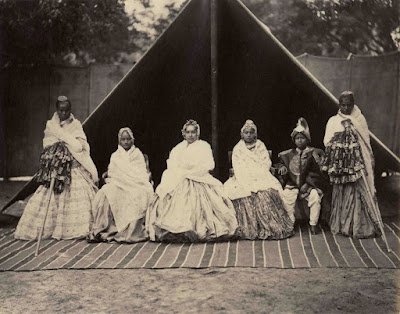 |
| Putali Maharani with family, Babar Jung her son. Picture by Samuel Bourne |
Putali was one of Jung’s favorite wives and Jung owed a lot to her. As a palace maid Putalibai in the service of the Junior Queen Rajya Luxmi Devi, she had reported to Jung the goings in the royal household, the competition of the two queens to gain an upper hand, the shenanigans of the feeble minded king, the plots and counter-plots. Jung knew that to survive and thrive under these circumstances, he needed to know which way the wind was blowing constantly so that he would himself not be blown off course. Putali was a clever plant in the royal household, a spy, and a lover. Putali was a Newar girl, a daughter of the Dangol gardener of Jung Bahadur’s Thapathali Durbar, a maternal inheritance from the Thapa clan. She was very loyal to Jung.
 |
| “Muna Madan” book cover |
Putali was familiar with the Newa bhasa balad made famous later in Nepali by the great poet Laxmi Prasad Devkota titled “Muna Madan”. Madan the protagonist leaves for Lhasa to reap rich reward in trade and leaves behind a very young bride Muna in Kathmandu. Madan undergoes much hardship but returns with a potful of gold but gets sick en-route and his friends leave him for dead. The friends reach Kathmandu and report to the bride Muna that her husband died on the way back. Madan is saved however by a good-hearted low caste man and brought back to Kathmandu in good health only to find that his Muna has died of grief. Putali always teared up whenever the play was put on by artists at the Thapathali Durbar.
Newar traders had established a history of trading with Tibet since times immemorial. In fact this history certainly goes at least as far back as to the 7th Century Licchavi period when Nepalese Princess Bhrikuti, daughter of King Amsuvarman, was given in marriage to Tibetan king Srong-Tsen-Gampo. Sadly all this was temporarily halted and China took over the gold trade after the disastrous war of Regent Bahadur Shah. Instead of exerting more authority the expanding Gorkha kingdom had come under an existential threat. Prime Minister Jung Bahadur had now overturned the terms of the unfair treaty and with the Treaty of Thapathali signed in 1856 A.D. gained for Nepal an annual tribute of ten thousand Rupees, customs free trade facility for Nepalese traders with the right to trade in jewellery, ornaments, grains and clothes, and with the Tibetans agreeing to receive a permanent Nepalese Residency in Lhasa to monitor the welfare of the Nepalese community there.
 |
| Young beauty Putali |
Putali had the good fortune of being one of Jung Bahadur’s wives and she had already given birth to a son Babar Jung. She was comfortably ensconced in a wing of Thapathali Durbar overlooking the beautiful Putali Bagaincha, the Butterfly Garden. However her Dongol clan was still mired in poverty and she implored Jung Bahadur to send her sisters and their families on trade missions to Lhasa to reap the benefit of the new circumstances now prevailing there. The traditional Newar trading houses of the Dhakhwa, Sakya and Tuladhar families were again free to trade without legal impediment or security risk and Putali wanted her Dongol clan to join in this opportunity.
As we can see this did happen and her family members including her two sisters took this opening and proceeded to Lhasa to set up trading houses and participate in the marts that was periodically organized. The family lived there and as history unfolded we can see one of Putali’s nephew Bhairab Bahadur acquiring a station of high rank as the China and Tibet expert in the Munsi Khana or Foreign Office. He was sent by Maharajah Chandra Shumsher Jung Bahadur Rana on Nepal’s last quinquennial mission to China in 1908. The Shumsher clan was eternally grateful to Putali as she adopted the motherless Bir Shumsher and raised him together with her own son Babar Jung. As a Newar girl ‘married’ at pre-adolescence to the bel-fruit, a species of wild apple, in the traditional Bel-Bibaha, Putali was never going to be a widow and there was no need for her to commit Sati upon the sudden death of Maharajah Jung Bahadur Rana. She was not a part of Jung’s final hunting retinue as she was mourning the untimely death of her son Babar Jung from consumption only a few months earlier. She became the revered golden widow of Maharajah Jung Bahadur Rana until her death.
 |
| Chir Kazi Bhairab Bahadur Dangol in China, 1908 A.D. |
Comments Off on THE GOLDEN WIDOW
RANA COURT PHOTOGRAPHERS
April 18th, 2018It is but ironical that it has now become fashionable for many Nepalese households and public places such as restaurants and bars to display photographs of the Rana rulers of Nepal and their families, the men with their military decorations covering their broad chests, with plumed crowns on their heads and women bedecked in beautiful diamond and emerald encrusted tiaras and other pieces of sparkling jewelry set on valuable metal. Ask the owners and many would not recognize who those Rana figures are; it is merely the proximity to power, fame and now what is considered to be a fascinating period of history that people vicariously yearn for. A mere couple of decades back the Rana rulers were reviled as autocrats but in the intervening years people have come to realize that whosoever comes to power in Nepal aspires to be a Rana anyway!
Scrutinizing carefully the portraits and pictures of old Nepal one can sometimes discern the faint names of the photographers or photographic studio these pictures come from. If the pictures are from the period of Rana prime ministers Maharajah Jung Bahadur Rana and Ranauddip Singh Rana, they would invariably come from the studio of Bourne and Shepherd. The period between 1860 and 1900 was covered by the lens of Samuel Bourne who visited Nepal with his assistants and a full studio in tow. Cameras were very rudimentary and clumsy equipment then and the pictures were produced on 10×12 inch photographic plate by cumbersome process called Wet Plate Collodian.
 |
| Portrait of Maharajah Jung Bahadur Rana by Samuel Bourne |
If one looks closely at pictures from 1930 to 1945, one can see that these were developed by Studio Matzene. Time brought technological advances in the art of photography and photographic films were discovered. One sees the name Matzene embossed on portraits of Maharajah Bhim Shumsher and his family and also Maharajah Juddha Shumsher and family. Just who were these photographers who took these historical portraits and photographs in Nepal and how did they get here at a time when very few foreigners were allowed to set foot in the country? We need to closely look at the life and times of Samuel Bourne and Richard Gordon Matzene.
 |
| Samuel Bourne |
Samuel Bourne came from England to India in 1863 A.D. as a young man of 29 where he did his most impressionable body of work photographing monuments, Himalayan vistas and aristocracy. He teamed up with another photographer Charles Shepherd and started Bourne and Shepherd Studio in Shimla, then the hill station frequented by the important people of the Raj. He traveled extensively in India including embarking on two successful trips to the Himalayan mountains in search of the source of River Ganges at Gangmukhi. As his renown grew the Nepalese rulers must have heard about him and his studio and Bourne was invited to Nepal to take photographs of the ruling family. We see pictures of prime minister Jung Bahadur Rana and his family in various poses and locations. He probably arrived in Nepal in 1868 A.D. as some pictures carry this date. By this time he had opened a second studio in Calcutta in 1866 and hence he must have come to Nepal from Calcutta.
 |
| Jung Bahadur’s Wife with son and daughters in hunting camp by Samuel Bourne |
It is quite apparent that Samuel Bourne found Maharajah Jung Bahadur Rana in his hunting camp and a few pictures existing today is from this era. There are also portraits of Jung Bahadur he shot most likely in his Thapathali Durbar. It could also be possible that some of these portraits of the period were actually shot in the Bourne and Shepherd Studio in Calcutta as it is documented that Jung visited Calcutta during the early sixties, a few years after the Indian Mutiny of 1857 A.D. when Jung supported the British and jointly with British forces the Gurkhas took Lucknow. Samuel Bourne eventually returned to England and he died there in 1912. Bourne and Shepherd Studio in Calcutta closed down just a few years back in 2016.
 |
| Richard Gordon Matzene |
Richard Gordon Matzene was a well-known photographer and an art dealer. Born Jens Rudolph Matzene probably in Denmark he later changed his name when he started to reside in America. He claimed to be a Count but sources do not confirm this as many Europeans took dubious royal titles to impress the Americans who still had a fondness for anything royal albeit after having thrown out British Colonial rule. Matzene first opened his studio in Chicago in 1900 and later went to Hollywood during the formative years of cinema. He took very artistic pictures of lady artists of cinema, ballet and theater of the time. He is known to have traveled extensively and opened several studios overseas, one in Shanghai and the other in Shimla, by now the summer capital of the British Raj.
 |
| Maharajah Bhim Shumsher and his youngest wife Sita Badamaharani with daughter by Matzene |
Matzene came to Nepal to take official portraits of the Rana rulers of the time. True or false a book on his life claims that he was the 27th foreigner to get a visa to visit Nepal. It is more likely that it was in the Shimla studio of Matzene that the Rana rulers of Nepal and their families took their official portraits. Prime ministers Bhim and Juddha went there for this purpose during their official visits to India. My father General Kiran Shumsher Rana definitely visited the Matzene Studio in Shimla for his family photographs. The author of a book on Matzene Marcela Sirhandi visited Nepal in search of material to write, “Royal Nepal: Through the Lens of Richard Gordon Matzene”. I had the opportunity to meet her but her collection of photographs was already complete from eclectic sources and it was too late for me to hand over to her our family portraits. Matzene’s photographic works and his oriental art collections are housed in University of Oklahoma and Ponca City Library in Oklahoma.
 |
| Marcela Sirhandi’s book on Rana portraits by Matzene |
Many Nepalese photographers were subsequently trained. One of the first Rana family member to become fascinated with this new art form was Major General Dambar Shumsher, younger half-brother of Maharajah Bir Shumsher. He raised Nepalese photographic standard to new heights training local aspiring photographers with his active encouragement. This love of portraiture was further carried on by his son Samar Shumsher and his famous artist-poet-dramatist grandson Bala Krishna Sama. They must all have been highly influenced by the technique applied by Samuel Bourne and later by Richard Gordon Matzene, two of the best photographers of their respective time the British Raj was blessed with.
Comments Off on RANA COURT PHOTOGRAPHERS
THE DELHI DURBARS AND THE RANA REGIME
March 21st, 2018 |
|
The Delhi Durbar 1877 |
Maharajah Jung Bahadur Rana was thrilled to get the confirmation of his long sought-after ambition: to host a British Royal in Nepal. Following his visit to England in 1850 A.D. at the invitation of the British government as an ambassador of the King of Nepal, he wanted very much to repay the gracious hospitality of the British Royal family he had enjoyed. Now the news came to Kathmandu with a kharita from Lord Robert Lytton, Viceroy of India, that the Prince of Wales had accepted the invitation to visit Nepal Terai for a shikar, a big game hunt, during his visit to India 1875-76. During the prince’s sojourn in Calcutta Jung had sent an embassy headed by his second in command Ranauddip Singh to invite the prince. The British had planned the hunting expedition to Nepal from the west crossing the Mahakali River to what is now Suklaphanta Reserve.
Jung Bahadur was a man of action; he hastened to make the preparation for the royal visit. Leaving his affinity to the jungle and fondness of hunting aside, he remembered too his hardship years herding wild elephants and training them and domesticating them for commercial purpose. After the fall of Bhimsen Thapa his maternal grand-uncle from the post of prime minister, Jung had to rely on this trade for sheer survival. He knew more than most how to tame the jungles and manage a hunt.
After the hunt was concluded successfully, Jung Bahadur decided to send his second man in command Commander-in-Chief Ranauddip Singh to the Delhi Durbar of January 1877 as the representative of the King of Nepal. A large retinue was constituted to travel to Delhi together with some high ranking army officers and camp assistants. This was the formal occasion of handing over all the powers of the East India Company to the Crown. Nepal was at peace with the Raj following the Anglo-Nepal War of 1814-16 and Jung Bahadur meant to keep it this way, the only way he was convinced that Nepal would remain independent since one native state after another, including the powerful states of Oudh and the Punjab, were already gobbled up by the Empire. Without preventive diplomacy Nepal could be next.
Commander-in-Chief Ranauddip Singh had the opportunity of rubbing shoulders with the glittering array of Indian maharajahs and nawabs gathered there for the occasion. Lytton the Viceroy left no stone unturned to make this Durbar as opulent as the ones held during the Mughal period, the last dynasty that ruled most of India before the British took over. He wanted all India to see the symbolism of crowning Queen Victoria at the seat of the Mughal emperors and not in the capital of the Raj that was Calcutta. Ranauddip was awarded the freshly minted Kaiser-I-Hind Gold Medal during the occasion. There was present a very young and ambitious nephew of Ranauddip Singh in his retinue who watched closely the goings-on mesmerized by the pomp and circumstance the occasion merited. He was awarded Kaiser-I-Hind Silver Medal on the occasion. Little did he know then that he would be representing Nepal as its prime minister at the next two Delhi Durbars!
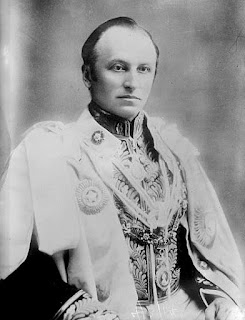 |
| Lord Curzon |
George Curzon was the new viceroy of India. He would be remembered for the restoration of many historical and archaeological sites in India including the Taj Mahal. He would also be remembered for organizing the great Delhi Durbar of 1903 to mark the accession of King Edward VII to the British throne. An arch conservative he reveled in grandiose plans for the British Empire including stopping the perceived Russian threat to India via Persia, Afghanistan and Tibet. He enjoyed big game hunting. It is said that he had invited himself to Nepal Terai for a shoot during the final year of Maharajah Bir Shumsher but by the time it actually materialized Bir was dead and his brother Dev Shumsher was the prime minister. So soon after assuming office Dev was not in the right frame of mind to personally host Lord Curzon and sent his Commander-in-Chief Chandra Shumsher instead. This is viewed as a great mistake on the part of Dev as during the hunt Chandra forged a personal relationship with Curzon portending dire consequence for the tenure of Dev as prime minister. This is why the British Raj did not question why Dev Shumsher was within three months of taking office removed by Chandra who assumed the office himself. A quid pro quo was struck at the shikar camp.
Lord Curzon wanted to organize a Durbar the ages would remember. He personally took charge of the project and made a vast tented city in the Delhi maidan. The invitation list was extensive as all the Rajas and Maharajas in the vast Indian sub-continent was to be included for the homage to the King emperor. The only dampener to this event was the news that King Edward VII would not be personally attending the Delhi Durbar. Hiding his disappointment Curzon set out to preside over the event himself, a singular honour for such a vainglorious person.The Indian royalty were seated during the occasion as per their hierarchy denoted by the number of gun salute their station was granted by the Raj. Each ruler was outdoing the other in showing off their finest uniforms, sparkling jewellery and the opulent sirpech or headgear.
 |
Indian Ruling Princes in attendance at Delhi Durbar of 1903, second from right is Chandra Shumsher of Nepal |
Maharajah Chandra Shumsher attended the Durbar representing the King of Nepal. It was a great opportunity for him to meet all the important personages of India and to cement ties with the British. He was keen to follow the course his uncle Maharajah Jung Bahadur Rana had half a century earlier set for Nepal vis-a-vis the close cooperation and friendship with British India. Chandra’s earlier attendance of the Durbar of 1877 must have stood in good stead for the wily ruler as it is said a twenty minutes courtesy call on Lord Curzon the Viceroy actually lasted for over an hour and a half. Chandra had given his support, both logistical and military, for the British to organize an expeditionary force into Tibet to forestall the so-called Russian threat.
 |
|
King George V and Queen Mary at the Red Fort |
Comments Off on THE DELHI DURBARS AND THE RANA REGIME
RANI MAHAL, STORY OF ITS MAKER
February 2nd, 2018PROLOGUE
The Delhi Durbar of 1903 A.D. was a celebration of Empire to mark the Coronation of King Edward VII. Not since the Durbar of 1876 to celebrate the crowing of Queen Victoria as Empress of India did the Raj put on a show of this magnificence. Lord Curzon the Viceroy made sure that this Durbar would be even more of an extravaganza than the earlier one and all the Indian Royals would be there to celebrate such singular an occasion with pomp and circumstance it merited. A tent city was created in the vast maidan of New Delhi. Lord Curzon invited Maharajah Chandra Shumsher Jung Bahadur Rana from Nepal for the occasion. It was an acknowledgement of the fact that British India had nothing negative to say on the matter of the ouster of Maharajah Dev Shumsher from power just a year back and that it was ready to do business with Chandra. Chandra would not miss such an occasion to show his gratitude and make friends with Lord Curzon.
 |
| Maharajah Kashmir (turbaned, 2nd row), Scindia of Gwalior, Nizam of Hyderabad, Wodiyar of Mysore, Chandra Shumsher of Nepal, Gaekwad of Baroda (Front Row L to R) all 21-gun salute states |
Chandra regaled on the occasion rubbing shoulders with the pride of the Indian Princely States as the ambassador extraordinary and plenipotentiary representing the King of Nepal. This was his own launching on the “world” stage. However, to dampen his spirits, news had come from his spies in Nepal that, taking the opportunity of his absence from Nepal, his elder brothers were up to mischief. His eldest full brother General Khadga Shumsher had been taken off the Roll of Succession for plotting against the then Prime Minister and Maharajah Bir Shumsher. His own immediate full brother Dev Shumsher considered too weak to rule had been collectively removed by himself and his younger brothers. These were the two disgruntled elder brothers now exiled from Kathmandu but living in Palpa and Dhankuta respectively who were conspiring together to take back their rights and privileges. Chandra was a shrewd operator. He knew he had to deal immediately with this threat before it became insurmountable.
 |
| General Dhir Shumsher and his seventeen sons, Bir, Khadga, Dev, Chandra, etc. |
How had these turn of events taken place and shaken up the Rana nomenclature in Nepal? How had two elder brothers of Maharajah Chandra been ousted from the seat of power? General Khadga Shumsher was the mastermind behind the assassination of Maharajah Ranaoddip Singh Kunwar Ranaji. As his elder half-brother Bir waited in the wings nervously awaiting the outcome of the assassination bid, it was Khadga who was the hot-headed young man of just 23 years who took destiny in his own hands and actually, with a few of his younger brothers, ventured to Narayanhiti Durbar that fateful November night. After the successful coup d’etat Bir had been crowned the Maharajah of Kaski and Lamjung and became the prime minister of Nepal. Khadga became the Commander-in-Chief of Nepal, the second most powerful post in the Rana regime. As the saying goes,”uneasy lies the head that wears the crown”, and no sooner had Bir been crowned than he started to look over his shoulder askance at his ambitious younger half-brother Khadga. Would not Khadga mount another coup d’etat and finish him off? Bir was petrified.
 |
| General Khadga Shumsher J. B. Rana |
No one can really be sure what happened next but Bir was given irrefutable evidence of a plot Khadga had hatched to do away with Bir during a wedding ceremony. Khadga was arrested and struck off the roll of succession and even his descendants could no longer be in the Roll. Such was Bir’s ire. This was a departure from earlier practice of striking off only the culprit but not his whole family, as in the case of General Badri Narsingh Rana, found complicit in a bid to assassinate his elder brother Maharajah Jung Bahadur Rana. His sons Kedar Narsingh and Dhoj Narshingh were not removed from the Roll. Khadga was imprisoned in Thada. Later he was pardoned and given the post of Governor of Palpa in 1889 and Dhankuta in 1891.
 |
| Rani Mahal, Palpa |
After the death of Bir in 1901 A.D. the next in line was Dev Shumsher, younger brother of Khadga. Dev was a liberal to some, a playboy to others, a threat to the regime of his younger brothers nonetheless. Chandra the next brother in line was a more astute politician and he was afraid that Dev would succumb to the plots Khadga was bound to hatch to retrieve his lost position of the prime minister. In only three months after his coronation Dev was ousted and banished to Dhankuta. Now Chandra had two elder brothers to worry about instead of just one!
 |
| Lord Curzon the Viceroy with Maharajah Scindia of Gwalior |
General Khadga would have been so proud of her. Her later accomplishments as a consummate Indian politician must have come in part from the old General’s genes. He passed away in Sagar in December 1921 at the age of 60, a mere two years after Lekha’s birth. Never was he to see his Nepal or his Rani Mahal again.
Comments Off on RANI MAHAL, STORY OF ITS MAKER
ON DIVINE REVELATIONS
October 9th, 2017When the founder of modern Nepal King Prithivi Narayan Shah likened his new Nepali state to the “yam between two boulders” he was referring to the fragile state of his new kingdom lodged perilously between Mughal India and Qing China. Whether those were his actual words or words put later in his mouth by patriotic followers is really irrelevant. The sentiment is clear. During 104 years of the Rana regime such divine revelations from King Prithivi’s descendants were firmly muted. The royal revelations started to come thick and fast during the Panchayat Era. The leading newspapers headlined daily Shree Panch ko Mahaan Bani (His Majesty the King’s Words of Wisdom) and Radio Nepal did not start its newscast before reading one. King Mahendra was a poet so he probably did not have much difficulty formulating these revelations during his regime. The clarion call to Nepali nationhood “ma mare pani mero desh banchi rahos” struck a chord among many. During King Birendra’s time however one can imagine the palace press secretary scratching his head and working overtime! Churning out these pearls of wisdom for the masses on a daily basis, day after day, season after season and year after year must have been a painstaking task. A less patient person would have resigned in frustration!
Mao Zedong actually did one better as his earthly proletarian utterances were compiled into the little Red Book for his masses to read. It was no doubt an instant bestseller in Communist China. People did not leave their houses without one tucked in their pockets to guide them through the onerous chore of state building. Teachers referred to it while teaching Dialectical Materialism to their pupil. Engineers referred to it while building dams. Doctors saw guidance in his utterances during crucial medical interventions to save human lives. China went mad!
One of the oldest revelations I am familiar with from my schooldays is the voice from heaven to Abraham. Moses got his Ten Commandments directly from God and if you want to believe the Hollywood movie it was even inscribed by lightning in a stone tablet, and in English! Muhammad got his revelations directly from Allah. References to some aberrations that crept in the Koran later blamed on Satan for these errant verses got the unsuspecting author into mortal trouble after riots protesting this profanity ignited in Hindu majority India! Not to be outdone, the Iranian Ayatollah put a fatwa on him!
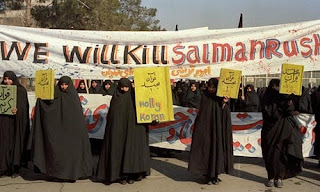 |
| Demonstration in Teheran over The Satanic Verses |
Ok, so what is the point of this blog? Of course, it is to explore what pearls of wisdom the Rana rulers of Nepal imparted to the masses during their 104 year long regime. Could they have ruled for so long without such revelations? Nobody can. Tsarina Alexandra relied on the psychic Rasputin to cure her hemophiliac son the Tsarevich Alexei. Indira Gandhi did not take a step in politics after the fiasco of the Emergency without the assistance of her soothsayers. Nancy Reagan dabbled in astrology. Even President Trump tweets his revelations to the dismay of his White House staff and to the chagrin of his bitter opponents who know that without Twitter Trump would not have been elected president in the first place. Is God working through social media in today’s world?
Let us take a tongue-in-cheek look at what pearls of wisdom they left behind to the future generations? Prime Minister Jung Bahadur Rana gave us the Muluki Ain, the Civil Coda, for the first time in the history of Nepal and he got himself elevated to the title of Maharajah for his wisdom. “If you want to earn a good name, you must let go of greed and adopt compassion,” he advised his brothers. He continued, “If it will please the masses, don’t hesitate to kill even your own son. Forget about jealousy and anger, forget about wealth, and make moves that please the largest section of the population”. He had mastered the Machiavellian art of statecraft that was needed at the time to stay in power but his fortitude never wavered. He would often lecture, “If you have to lie in the course of politics, do it by deluding the masses so they remain happy”. Our current generation of leaders has at least followed Jung’s advice to the letter on this score. Jung was also astute enough to bestow the Roll of Succession to his younger brothers rather than to his sons. Was this the secret of the longevity of the Rana Regime? The brothers were tried and tested while his sons were raw and a wayward son would have destroyed the fruits of Jung’s labours! We can find resonance of his wisdom in what happened in the latter Shah period.
His successor Prime Minister Maharajah Ranauddip Singh prayed all the while for the betterment of his people. He did nothing more. His younger brother Commander-in-Chief General Dhir Shumsher handled the affairs of state with strength and foresight. Ranauddip’s prayers were answered as long as Dhir lived. After Dhir’s passing even the Gods could not save him from his fate! His nephew Bir Shumsher took over the reins of power.
Bir loved music and the arts. He loved beautiful paintings and sculptures. He constructed European neo-classical style buildings in the heart of Kathmandu that were designed by European architects taking after the storied palaces of Europe such as Versailles in Paris and Schonbrunn in Vienna. Bir patronized the theater and dancing. His harem constituted a plethora of dancing girls with theatrical nicknames like Zarina, Nur Jahan, Ishq Bahar, Nasim Pari, Rosa Pari and Sartaj Pari. Bir changed the musical landscape of Kathmandu! “If music be the food of love, let’s play on and on,” was his motto to paraphrase Shakespeare.
His successor Dev Shumsher was supposed to be the liberal one – perhaps because he did not experience the deprivations suffered by his brothers since, from a young age, he was brought up in the rich household of his childless uncle General Krishna Bahadur Kunwar. It is easier to be a liberal without having to battle for your daily bread. This reminds me of the innocent question a Shah king was known to have asked when he went to behold how the masses fared. “Don’t they even get to eat milk and rice?” he exclaimed in wonder to the consternation of his minders.
Dev was ousted within months for his liberal-mindedness. His successor Chandra was the austere one. Stricken with an incurable tuberculosis since an early age, the gaunt Chandra came to represent the implacable face of the Rana Rule of Nepal for some 28 years. People remarked with dread, “Should Chandra smile a dire calamity will befall on us!” With the inevitable trajectory of time, Chandra opened the first institute of higher learning in Nepal – Tri-Chandra College. He is known to have confided to his courtiers that he has hammered the first nail in the Rana Regime’s coffin!
It was during Maharajah Juddha’s watch that Godly revelations came to the fore. God-men in India today hold vast influence over the hopeful and the hopeless in huge swathes of territory with their divinely ordained missives. Maharajah Juddha also needed them here as Nepal firstly succumbed to the devastating 8.0 magnitude earthquake of 1934 A.D. and secondly to a burgeoning popular movement towards democracy partly fueled by the Indian movement to oust the Raj. Juddha did try to get the support of the masses. There is an apocryphal story that the Maharajah periodically invited hundreds of the destitute and the deprived, mainly from the lower castes, for delectable feasts and asked them to open up their minds. With some imbibing of local spirit the brave among them did so freely and gave the absolute dictator an idea about what the people were thinking. What he heard and what his guru Resunga Mahaprabhu prophesied sealed his own fate. He was the only Rana prime minister to resign from office. After a quick succession of two more prime ministers – Padma and Mohan – the 104 years of Rana Regime of Nepal went into the history books!
Today’s Nepal has taken a precarious step towards federalism as enshrined in the newly minted Constitution. There lie many challenges ahead. There will be ever more room for divine revelations to come to the fore to tackle these challenges. Some of our leaders will no doubt get their inspiration from more earthly figures of Marx, Lenin and Mao. There is a danger lurking somewhere that King Prithivi Narayan’s fragile “yam” might be crushed now among the seven federated boulders.
Comments Off on ON DIVINE REVELATIONS
LOOKING BACK AT A BETRAYAL MOST FOUL
October 9th, 2017Maharani Haripriya Devi was now a refugee in Benaras. She looked back in anger at what had transpired in Nepal. She trembled with fear and paled at the memory even now when she remembered that terrible event! Yes, she had delved in politics while she was the titled maharani to Maharajah Ranoddip Singh, the prime minister and de facto ruler of Nepal. But wasn’t it warranted? Her husband was a kind-hearted man but weak. He could never be as commanding and forceful as his elder brother Maharajah Jung Bahadur Rana. He was constantly being over-shadowed by his younger brother Commander-in-Chief General Dhir Shumsher as her husband was content in having his brother rule but in name. She could not tolerate this affront for ever. Could she? But she had failed, she began to tear up….
 |
| Maharajah Ranoddip and Maharani Haripriya |
Haripriya was the second wife of Ranoddip Singh, the 5th brother of Maharajah Jung Bahadur. By his good fortune he had inherited the mantle of Maharajah and post of prime minister after his eldest brother Jung Bahadur Rana’s sudden death during a hunting trip in February 1877 A.D. At Jung’s passing his older brothers Bam Bahadur and Krishna Bahadur had already died and Badri Narsingh had been removed from the Roll of Succession after an unsuccessful plot to unseat Maharajah Jung Bahadur had come to light. Ranoddip Singh was involved in many of the campaigns launched by Nepal to redress past wrongs. He was in the front when the Tibetans sued for peace. He was with his brother Jung knocking at the gates of Lucknow during the Indian Mutiny. He represented the King of Nepal in the Imperial Durbar in Delhi in January 1877 A.D. He did not have much family life until he remarried in the hope of having an heir.
The Maharani could not forgive the British for so casually ditching their friend Ranoddip Singh and Maharajah Jung Bahadur’s family. The current prime minister Bir Shumsher could not have survived the crime he and his brothers perpetrated without the British turning the other way. They had forgotten the years of friendship fostered under her husband. She couldn’t understand how the British could support the children of General Dhir Shumsher who was staunchly anti-British during his years as Commander-in-Chief. In deference to his stance the Maharani believed Ranoddip would not do the bidding of the British. However soon after the death of Dhir, most of the demand of the British with regards to the induction of the soldiers from Nepal for their Gurkha regiments had been fulfilled. Ranoddip had acceded to the plans of the British to raise another 5,600 troops from Nepal. In return he was successful in importing breach-loading rifles and gunpowder and lead to make cartridges for them in the country. Ranoddip had plans to lift the self-imposed state of isolationism of Nepal favoured by his brother Jung Bahadur.
 |
| Maharajah Jung Bahadur Rana with his sons Jagat and Jeet |
Haripriya felt a lot of sympathy for the eldest son of Maharajah Jung Bahadur, General Jagat Jung Bahadur Rana. Although she witnessed from the sideline the tussle between her husband Ranoddip and Jagat Jung on who would inherit the title of Maharajah of Kaski and Lumjung, she believed that it was unfair to remove Jagat from the Roll of Succession on trumped up charges of planning a coup d’etat against his uncle the maharajah. She knew that more than her husband’s it was the determination of Dhir Shumsher that ultimately sealed the fate of Jagat. Haripriya started advocating on Jagat’s return and restoration of status quo ante soon after Dhir passed away. She felt it only just that after her husband’s death the post of prime minster and the hereditary title of Maharajah of Kaski and Lamjung granted by King Surendra Bir Bikram Shah should be Jagat’s. She was a humorless, firm lady who started to call the shots now in lieu of her hen-pecked husband. She demanded that she wear a crown with plumes just like her husband’s and got it!
 |
| Two Daughters of Jung Bahadur from Maharani Hiranya Garva Kumari (1) Deep Kumari married to Prince Dhirendra famous as Bagh ki Kanchi Maiya, (2) H.M. Lalit Rajya Luxmi (mother of King Prithivi), Maharajah Ranoddip and his wife Haripriya Devi |
Haripriya felt bitter that fate would not give her children. She knew that her husband had married her in the hope of having a male heir as his first wife died without any. She felt guilty that she had let him down. He was a good and deeply pious man who spent his time writing devotional songs and singing hymns. She persuaded Ranoddip in adopting a son of his elder brother the hapless Badri Narsingh Rana as their own. Thenceforth he was to be known in Durbar circles as Crown Prince Dhoj Narsingh Rana. But all this had come to nought.
 |
| General Dhoj Narsingh Rana |
Her forceful advocacy on behalf of General Jagat Jung the deposed and exiled heir of Maharajah Jung Bahadur had started to ring alarm bells in the Shumsher Rana camp. Jagat Jung’s half sisters, the four daughters of Jung Bahadur Rana’s principal wife Maharani Hiranya Garva Kumari were firmly in the Shumsher camp too. They were very influential as all of them were married to members of the Nepalese Royal family, two of them to Crown Prince Trailokya. General Jagat Jung’s return would create havoc in Nepalese politics with unforeseen consequences. They were not going to allow this to happen at any cost. But happen it did! They put the blame squarely on the shoulders of Ranoddip the prime minister. Now all they wanted was revenge.
That November night in 1885 while Maharajah Ranoddip Singh was reading his hymns and getting an oil massage from the palace maids, Maharani Haripriya Devi was present too in the bed chamber, content in the knowledge that after Dhir Shumsher’s passing her will was being imposed on her husband, slowly but surely. General Jagat Jung was already back in Nepal from his exile and restored to the Rana family’s Roll of Succession in 1884 A.D. The British were happy now that their demand for more Gurkha recruits were being met. They had both adopted Dhoj Narsingh as their own son. Suddenly all this secure feeling for her future unraveled before her eyes in a matter of a minute! Maharani Haripriya now relived the nightmare once more; she saw again through her tear-filled eyes sons of General Dhir Shumsher bursting into their bed chamber and shooting her husband dead in front of her very eyes! Her husband died in her arms with the name of Ram in his lips. Why hadn’t they not shot her too? Her life in Benaras was one of misery. The petitions to Lord Dufferin the Viceroy of India from the ousted sons of Jung Bahadur and her own adopted son to not recognize the regime of Bir Shumsher fell on deaf ears. The British Raj and providence had abandoned them.
Comments Off on LOOKING BACK AT A BETRAYAL MOST FOUL
WHEN THE EAST MET THE WEST
June 19th, 2017Rudyard Kipling famously opined that “East is East and West is West and never the twain shall meet”. He was obviously referring to the post-renaissance materialistic philosophy that started to take hold in the west while the spirituality of much of the east had not changed with time. He would have experienced it first-hand having been born and raised in India and then having spent his adulthood in Britain. What is surprising is that socio-politically though the west was as backward perhaps as many parts of the east through much of the nineteenth century. Criticism of the ways of the Rana rulers of Nepal and similar family oligarchies of the east, especially coming from erudite western commentators, sounds quite hollow when similar absolute monarchies and dictators were ruling the roost in their own backyard. “Empire” was evil in its own nefarious way, let us not forget it. Not to sound like an apologist for the excesses of the Rana period, I would like to submit here that this was the way of the world – east or west – period!
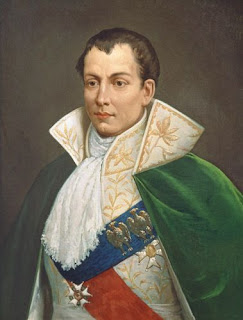 |
| Joseph, elder brother of Napoleon |
Napoleon Bonaparte not only crowned himself Emperor of post-revolutionary France but also succeeded in making his brother Joseph King of Naples and Sicily by decree in 1806 and got recognition from Prussia and Russia. Later he became the King of Spain. Napoleon’s son Francois was crowned King of Rome! Napoleon re-arranged the map of Europe like nobody had done before him. General Bhimsen Thapa was Napoleon’s contemporary in Nepal. Had he not clashed against the superior military might of British India, he would have carved up much of the Himalayan region into a Greater Nepal. Prime Minister Jung Bahadur Rana had himself crowned the Maharajah of Kaski and Lamjung albeit by decree of a powerless King Surendra Bir Bikram Shah. Both of them were very much our Bonaparte!
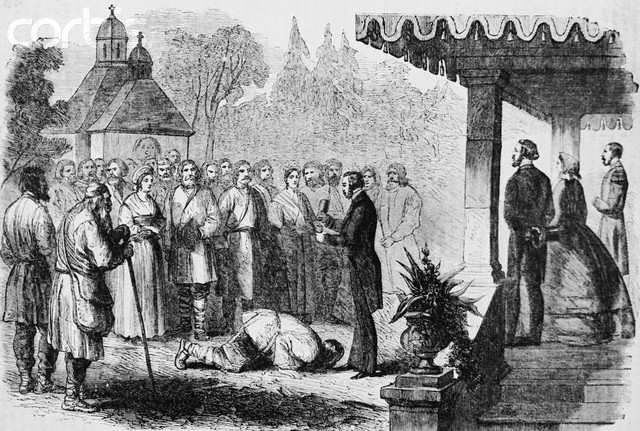 |
| Emancipation of serfs in Russia, 1861 A.D. |
Russia still had serfs during this entire period leading up to the death of Czar Nicholas I in 1855 A.D. Only by 1861 did Russia legislate the emancipation of serfs under the liberalizing influence of their new Czar Alexander II. Jung Bahadur had himself tried to end the inhuman practice of slavery and suttee but he could not succeed during his lifetime. Had Maharajah Jung Bahadur Rana managed to visit Russia as originally planned following the visit to Britain and France in 1850, he would have seen a country much like his own. Nicholas I was a martinet and Jung would have found common cause with him regaling in military parades and elaborate and lavishly prepared state occasions. Notwithstanding the setback Russia suffered during the Crimean War, under Czar Nicholas I Russia had gained a huge empire to the south and east bordering Persia, China and through Siberia to the Pacific Coast. Empire building was the norm and the European powers were outdoing one another trying to gain footholds in faraway lands and control their resources.
The sun never set in the British Empire during much of 18th and 19th centuries. The largest land mass any empire had acquired in world history, the empire covered 6 Continents and similar time zones. At any given instance there was bound to be daylight in some corner of the empire! After having lost America to its independence India became the jewel in the crown. A trading company set up under a Royal charter in early 17th century had opened its first trade post in India in Surat in 1613 A.D. under a special concession granted by Mughal Emperor Jehangir. The Honorable East India Company had devoured much of India in a hundred years since. Similarly the House of Gorkha had conquered Kathmandu Valley and expanded their territories through much of the mountainous regions south of the Himalayan massifs. In an age when an European power thousands of miles away could take control of the multitude of nation states of South Asia – both Muslim and Hindu – and subjugate them in the name of civilizing them, then nobody should begrudge the Gorkhalis for unifying disparate and largely backward mountain tribes and forging a great nation state in the laps of the Himalaya!
Expediency dictated that Nepal under the Rana regime forge close ties with the British rulers of India. It was but a natural reaction to self-preservation. After the Treaty of Sugauly truncated the territories of Nepal which were acquired decades earlier, the rulers saved Nepal as an independent state. It is an open question what Nepal would look like today had the British taken over and, like all other princely states of India, handed us over to an independent India notwithstanding the various treaties and agreements the British had signed earlier with those princely states. One thing is for sure, our Maoist insurgency would have been either nipped in the bud or would be festering like a gangrenous sore as in a few parts of India today.
Comments Off on WHEN THE EAST MET THE WEST
UNEARTHING THE ARTIST BEHIND THE PERSONA
February 10th, 2017In my European travels I marvel at famous works of art and praise the genius of portrait artists such as Michelangelo, Leonardo da Vinci, Raphael, Vincent van Gogh, Rembrandt or Velasquez without a thought given to their subjects. Obviously these artists were commissioned by the aristocracy and nobility of their days to sculpt a bust or to paint a portrait of their benefactors. As time went by these artists, many after their death, started getting recognition and their works of art started fetching unbelievable sums for auction houses. The rich would buy a Velasquez without a thought for who the forgotten likeness in canvas actually is and proudly decorate his living room with it.
Will such an eventuality come about in our local context? Will we see our often forgotten artists command a decent price for their works? We see olden statues of kings and prime ministers but we do not know who the artists actually are. Many artists behind the portraits of famous historical personalities may they be Shah kings or Rana maharajahs are relegated to anonymity. Would it not be possible to find out more on them?
Gazing at some of the Rana portraits of the early 20th Century one can see a signature – samar-krit – or “work of Samar”. Just who is this gentleman? Major General Dambar Shumsher was the second oldest son of Commander-in-Chief Dhir Shumsher, the youngest brother of Maharajah Jung Bahadur Rana. His passion for photography is well known and as an early aficionado he inculcated in his son General Samar Shumsher Rana the love of photography and portraiture. In my collection I have got Samar’s portrait of my grandfather Maharajah Juddha and my grandmother Tika Rajya Luxmi, third titled wife of Maharajah Juddha. This rich tradition was carried on by his son the pre-eminent Nepalese litterateur and artist Bal Krishna Sama! We remember his son Janardan as a popular Nepalese singer and musician.
 |
| Dambar Shumsher and family |
Another contribution of Dambar Shumsher and his family was to promote the talented Chitrakar family as court portrait artists and educate them in the art of photography and portraiture. Tej Bahadur Chitrakar was sent to Calcutta in the twenties during the time of Maharajah Chandra Shumsher to master the European style of portrait painting. Since then the Chitrakar family have been royal photographers and portrait artists. In my collection I have got a portrait of my great-grandmother Juhar Kumari Devi, mother of Maharajah Juddha Shumsher, painted by none other than Tej Bahadur Chitrakar in the thirties!
 |
| Tej Bahadur Chitrakar, portrait artist trained in Calcutta |
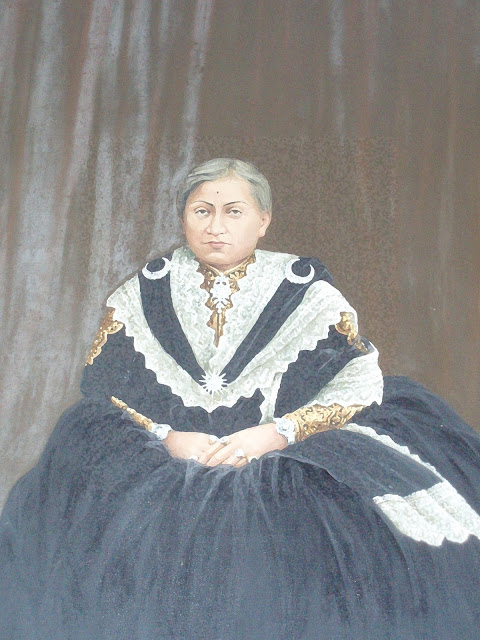 |
| Juhar Kumari Devi, mother of Maharajah Juddha by Tej Bahadur Chitrakar |
This brings us to the question of who were the sculptors of those magnificent equestrian statues of Shah kings and Rana prime ministers and their families. I did a blog on the Kathmandu statues some years ago but just who cast these magnificent statues and where was nagging me all the while. I was fortunate to be privy to a partial solving of these mysteries just recently. I got to meet Mrs. Chanda Rana, philanthropist and restorer, and learn that she had actually done some work on where these statues were cast and by whom. She kindly shared with me the records she had compiled and the article she had written for a local magazine.
The Tonelli family originated in Italy. Domenico Antonio Tonelli I (1806 – 1871) migrated to England and became a British subject before 1861. He is described as a plaster figure maker and modeller. He successfully conducted his business and passed on his skills to his son Domenico Antonio Tonelli II (1834 – 1919). He and his sister Elizabeth as assistant continued the family vocation. Domenico Antonio Tonelli III (1865 – 1953) and his brother James inherited this mantle. Domenico was awarded the title of National Scholar and became a member of the Royal College of Art. Some of the Rana statues we see today in Kathmandu is the work of this master craftsman.
 |
| Inauguration of Maharajah Jung Bahadur Rana’s statue in March 1885 |
Domenico worked at Fulthorne Studios in Paddington, London. For a time he was an assistant to Sir Alfred Gilbert the renowned sculptor who cast the Eros statue in 1886 A.D. now seen at Piccadilly Circus in London. Domenico must have been a master sculptor when the Rana regime in Nepal was looking to commissioning more statues of prime ministers and their families. We do not yet know who cast the magnificent statue of Maharajah Jung Bahadur Rana commissioned by his brother Maharajah Rannodip Singh after his death and unveiled with a lot of pomp in Tundikhel in March 1885 A.D. However the statues of Maharajah Dev Shumsher commissioned by his brother Juddha and now in front of the Jawalakhel Zoo was definitely cast by Tonelli III. So too were the statues of Juddha’s mother Juhar Kumari and his foster mother and sister-in-law Karma Kumari, wife of Dev, both placed by Juddha inside the zoo.
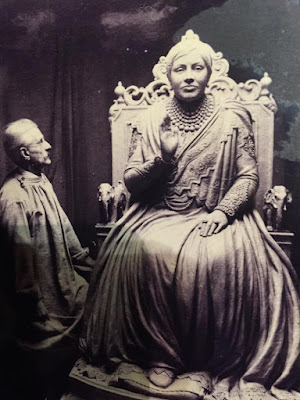 |
| Statue of Juhar Kumari Devi with creator Tonelli |
The statue of Maharajah Juddha placed at the newly constructed New Road built after the devastating earthquake of 1934 A.D. was also cast by Tonelli. There is a very interesting picture of the casting process by Tonelli.
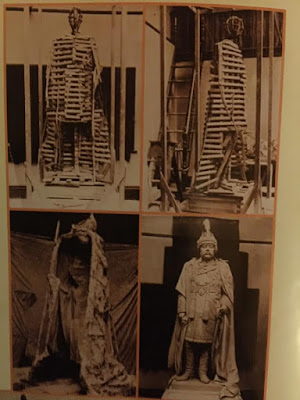 |
| Juddha statue now in New Road |
Domenico Tonelli eventually migrated to Australia and died there. It was because of his grandson Peter Tonelli’s fortunate record keeping that we have got a wealth of information on our statues or else we would lose an important part of our history.
Comments Off on UNEARTHING THE ARTIST BEHIND THE PERSONA
SPOILING FOR A FIGHT, THE INTERREGNUM BETWEEN THE FALL OF BHIMSEN THAPA AND RISE OF JUNG BAHADUR
October 27th, 2016One cannot help but wonder what would have happened if the Punjab, Avadh and other princely Indian states had formed an alliance with Nepal during the Anglo-Nepalese War of 1814-16 A.D. Subsequently what would have happened had Jung Bahadur Rana not sided with the British but aided the mutinous Indian states in 1857 A.D.? South Asian history might have been different.
Not since the war with Tibet and subsequent Chinese reprisal during the time of Regent Bahadur Shah did Nepal see such a reversal of fortune culminating in the Treaty of Sugauli. Prime Minister Bhimsen Thapa was compelled to sign the treaty with the British East India Company following the 1814-16 war. It was a colossal loss of face and fortune for the Gorkha kingdom since the conquest of Kathmandu Valley and the subsequent unification of Nepal. Almost one third of the country from the River Sutlej to River Mahakali in the west and from River Teesta to River Mechi in the east was now forfeited to the Company. A lesser person than Bhimsen Thapa would have seen the end of his days in power following such a cataclysmic turn of event but Bhimsen’s hold on power was such that he survived. Regent Queen Lalit Tripura Sundari still reigned in the name of her grandson the minor King Rajendra after his father King Girvan Yuddha died at the age of nineteen on 20 November, 1816 A.D. The Regent was Bhimsen’s own niece.
Ever since the ink had not even dried on the Treaty of Sugauli the Nepalese Court had zealous proponents of a second war with the British to salvage Gorkhali pride and retrieve lost territories. Nepalese politics since then would play out along the lines of pro or anti Company sentiments as expediency dictated. Only with the rise of Jung Bahadur Rana and his personal intervention on behalf of the British during the Indian Mutiny of 1857 A.D. did Nepal firmly establish itself as a friend of British India.
Regent Queen Lalit Tripura Sundari died of cholera in 1832 A.D. at a relatively young age of 38 years. The beginning of the end of Bhimsen Thapa’s long reign had begun. The martial clans that gave rise to the House of Gorkha under the Shah monarchs were the Pande, Basnyat, Thapa, Chautariya (royal collateral) and Kunwar chettry casts of the hill peoples. One or the other of their forebears had shone in the War of Unification and King Prithivi Narayan Shah trusted them with his life. These were the people in command of the military and the civil administration. The unity among these clans had however frayed at the seams and all of them were fighting for supremacy.
Shakespeare’s Macbeth makes a case brilliantly:
I have no spur
To prick the sides of my intent, but only
Vaulting ambition, which o’erleaps itself
And falls on th’other….
Senior Queen Samrajya Luxmi Devi was the real person in power after the king came of age and started to pull the reins of state. King Rajendra Bikram Shah was a weak person and he was under the sway of both his Ranis who pulled him in diametrically opposite directions leaving him in the proverbial position of between a rock and a hard place. Both the queens were extremely ambitious and both wanted their first born to succeed King Rajendra on the throne. Reports here are sketchy but stories tell of a second baby son of Queen Samrajya dying of poisoning, the poison having been intended for her consumption in the first place! Somehow the old man Bhimsen Thapa was implicated. Queen wanted revenge and the man to carry out her orders was no other than Ranajang Pande, the youngest son of the war hero and Mukhtiyar General Damodar Pande who was killed on the orders of Bhimsen Thapa some three decades earlier.
The family of Damodar Pande had their lands restored to them. They came back to positions of power and pelf. Ranajang became the Chief Minister and Commander-in-Chief in 1843 A.D. at the behest of the Senior Queen. The Pandes would now exact their revenge upon Bhimsen and his clan. Bhimsen himself committed suicide while in prison and his relatives including his nephew Mathabar Singh Thapa, the brother of Regent Queen Tripura Sundari, fled for their lives into the Punjab. Another interesting event had taken place in faraway Afghanistan that had the British preoccupied. The Afghan ruler Dost Mohammad had invaded the Punjab and the British were busy fighting the hardy Afghan tribes all the way to Kabul to install Shah Shuja as the new Afghan king. Ranajang Pande and the anti-Company factions in the court were waiting to strike at the British supported by a willing Senior Queen. Their ambition was further goaded by news that the British had started their first Opium War with China. An opportunity had presented itself to abrogate the Treaty of Sugauli!
 |
| Brian Hodgson |
Nepal sent a small expeditionary force across the border into India and occupied Ramnagar in Bihar in April 1840 A.D. Resident Brian Hodgson in Kathmandu and British India were shown a general disdain by all the actors in the court including Senior Queen Samrajya Luxmi Devi. This was a test of British intentions towards Nepal. A flurry of diplomatic activities ensued with Brian Hodgson imploring Lord Auckland, the British Governor General, to act strongly against Nepalese aggression. Ranajang Pande sent diplomatic missives to the Punjab and Avadh to form an anti-British alliance. Governor General Auckland sent a strong warning to Nepal to withdraw or face military action. They stood eyeball to eyeball until November.
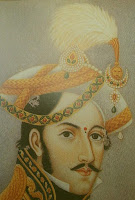 |
| Mathabir Singh Thapa |
King Rajendra Bikram Shah was spooked and he blinked first. He finally had the guts to take matters in his own hands and admonish his senior queen. He withdrew his troops. Her ambitions thwarted Samrajya Luxmi decided to leave for Benaras but she contracted malaria in the Terai and came back to Kathmandu to die at a young age of just twenty seven. With the demise of the senior queen the Pande clan once again lost all their perks and privileges and Ranajang Pande lost his mind. The door was now open to Junior Queen Rajya Luxmi’s long held ambition of having her own son Prince Ranendra succeed to the throne of Nepal. She would once again rely on the disgraced Thapa clan to realize her dream. Her first act was to recall Mathbar Singh Thapa from the Punjab to head the government.
 |
| Resident Henry Lawrence |
Mathabar Singh Thapa styled himself Prime Minister for the first time in Nepalese history and Commander-in-Chief and exacted revenge against all the courtiers who had contributed to Bhimsen Thapa’s downfall. Many prominent courtiers were physically eliminated. He became more powerful than the King. During his time in office he refused to do the bidding of Queen Rajya Luxmi to replace Crown Prince Surendra by her own son Prince Ranendra as the heir apparent to King Rajendra Bikram Shah. British Resident Henry Lawrence even warned the Nepalese palace that Mathabar was getting out of hand enlarging the army to pre ‘Treaty of Sugauli’ levels and posing a threat once again to the British Raj. He was keeping the Governor General Lord Ellenborough informed on Nepalese irredentism.
Mathabar Singh Thapa’s elder sister was the Regent Queen of Nepal Lalit Tripura Sundari, now deceased, and his younger sister Ganesh Kumari Devi was married to Kaji Bal Narsingh Kunwar. The Kunwars were closely associated with the Shah monarchy from the time of unification of Nepal. Bal Narsingh had risen in prominence after the assassination of ex-king Rana Bahadur Shah by his half-brother Sher Bahadur Shah. It was Bal who had killed the assailant. Their son Bir Narsingh Kunwar was a Captain in the army and attached to Crown Prince Surendra. Mathabar had changed his favourite nephew’s name to “Jung Bahadur” reflecting the time’s martial inclinations. In desperation King Rajendra and Queen Rajya Luxmi would turn to Jung to check the ambition of Mathabar by hatching a plot to assassinate him.
Queen Rajya Luxmi feigned sickness and summoned Mathabar Singh to Hanuman Dhoka Royal Palace. Against the warnings of his son and mother, it is said; he decided to go the the palace fully confident of himself. As he entered the courtyard shots were fired and Mathabar fell dead. His nephew Jung Bahadur had pulled the trigger, he later claimed under duress. Queen Rajya Luxmi was relieved. Now she would choose another more reliable person to do her bidding and fulfill her ambitions. She set her sights on the young Jung Bahadur. The meteoric rise of Jung had begun.
Comments Off on SPOILING FOR A FIGHT, THE INTERREGNUM BETWEEN THE FALL OF BHIMSEN THAPA AND RISE OF JUNG BAHADUR
Tracing The Genesis Of Nepalese Tea Industry
October 4th, 2016By Subodh Rana.
“Tea is better than wine for it leadeth not to intoxication, neither does it cause a man to say foolish things and repent thereof in his sober moments. It is better than water for it does not carry disease; neither does it act like poison as water does when it contains foul and rotten matter.”
 |
| Clipper ships used by tea traders |
Like the ancient Chinese adage succinctly attested to its merit, tea was recognized for its health benefits and served in all aristocratic homes in England by the time Prime Minister Jung Bahadur Rana visited London in 1850 A.D. It was already the beverage of choice for welcoming guests. American clipper ships had started to bring Chinese tea to London by then. Although still a very expensive commodity the British aristocracy and nobility along with their Dutch peers had already started enjoying the ‘cuppa’, aromatic green and black tea from China. It would be a matter of time before the whole population would be able to afford the joy of tea drinking and steer clear of addiction to coffee and lager.
The insular Nepal of Jung’s time did not have the expensive tea as one of the commodities purchased from China. Drinking this beverage was a privilege and Jung took to the taste. He drank it just the way the British did, adding to the black brew milk and sugar. Jung returned to Nepal with a plan to get the British to plant tea in his homeland. He knew that this beverage would be universally popular.
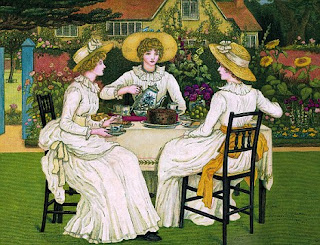 |
| Victorian High Tea |
Cultivation of tea outside China was started by the British and the Dutch having taken a fancy for the brew they encountered during their trade missions to China. They preferred the black tea over green. Although both green and black tea actually come from the same plant Camellia sinensis, it is the method of preparation that is different. The tea leaves are harvested, withered and heated by pan frying in the case of green tea and harvested and allowed to oxidize before drying in case of black tea. The leaves darken and produce a more defined colour and aroma. The British started cultivation of tea in their colonies in India and Sri Lanka primarily whereas the Dutch started cultivation in Sumatra and Java. Throughout the eighteen fifties and sixties Jung Bahadur’s Nepal saw imported tea coming from Assam and Darjeeling and the general populace was increasingly consuming this beverage. Maharajah Jung Bahadur knew that cultivating tea in Nepal was going to be a great domestic industry and, who knew, perhaps he could also export Nepalese tea overseas.
Maharajah Jung Bahadur’s great mentor was the old Englishman Brian Hodgson now residing in Darjeeling. Hodgson was extremely knowledgeable about Nepal and its politics having served at the British Residency in Kathmandu in various capacities initially and finally as Resident during the period 1833-44 A.D. He was Resident during the twilight years of Prime Minister Bhimsen Thapa and knew Jung Bahadur even before his rise to power. Jung relied on Hodgson’s counsel whenever he faced issues with the British and Hodgson was ever ready to assist Jung. It was to Brian Hodgson that Maharajah Jung Bahadur would turn to in his quest of starting a tea industry in Nepal.
His eldest daughter Maharajkumari Badan Kumari Devi had come of age and he was looking for a fitting groom. The eldest of his many children Badan Kumari was the elder sister of Jagat Jung and Jeet Jung, both of the brothers would play prominent role in the unfolding saga of Rana rule. Jung Bahadur had more ambitious matrimonial ties for them as he was looking at the prospect of marrying both of them to the royal princesses, daughters of King Surendra Bir Bikram Shah. But he had to give in marriage the elder sister first as was customary.
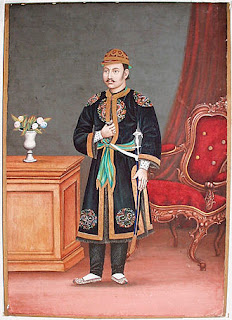 |
| Young Bhimsen Thapa |
The Thapa family was the old nobility of Nepal and the family’s chief patron was Prime Minister Bhimsen Thapa. Having ruled Nepal for over 30 years Bhimsen and his Thapa clan members had taken hold of many an important position in Nepal’s military and civil bureaucracy. But his career had come to an ignominious end during the reign of King Rajendra Bir Bikram Shah Dev. The opponents of Bhimsen had poisoned the king’s ears, even going to the extent of claiming that the death of his infant son was a result of connivance of Bhimsen. Bhimsen got despondent and committed suicide while in prison. Following the downfall of Bhimsen the Thapa clan and their relatives lost all their perks and privileges and had to undergo untold of privation and hardship until the rise of Jung Bahadur Rana.
Jung Bahadur himself was the grandson of Bhimsen’s younger brother Nain Singh Thapa from his daughter Ganesh Kumari Devi, hence he astutely played his role in restoring the fortunes of the Thapa family once in power. Now he would give his eldest daughter in marriage to Gajraj Singh Thapa who came from a renowned lineage of the Thapa clan. Gajraj Singh’s father was Kazi Hemdal Singh Thapa and grandfather was Sardar Achal Singh Thapa.
Prime Minister Jung Bahadur Rana knew that Indian nation states were destined to come under a British dominion and there was no use fighting the inevitable. The might of the British Empire was too great even for European powers to challenge as he observed first hand during his visit to Britain and France in 1850 A.D. English was fast overtaking Persian as the lingua franca of officialdom. He needed people with the ability to read and write in English in his court so that nothing would be lost in translation between himself and Calcutta. Around 1855 A.D. Jung decided to send his future son-in-law Captain Gajraj Singh Thapa to learn English under the tutelage of Brian Hodgson now residing at Brianstone in Darjeeling. Hodgson was delighted to be of assistance and appointed his own son Henry as the tutor until Henry’s death in 1856 A.D.
Jung had not forgotten his ambition of growing tea in Nepal. By the eighteen seventies branded tea from Darjeeling, Assam and Sri Lanka had gained worldwide appreciation and export was booming. British India companies Tetley, Brooke Bond and Grey were household names in many parts of the world. The best person to help realize his ambition was his son-in-law Colonel Gajraj Singh who was by 1873 A.D. Governor General of the eastern region of Nepal. Gajraj was asked once again to revisit Jung’s old mentor Brian Hodgson in Darjeeling and study the tea industry at close quarters. Hodgson once again obliged.
 |
| Colonel Gajraj Singh and Maharajkumari Badan Kumari |
Gajraj Singh Thapa successfully started a tea plantation in the region of Soktim in Ilam in eastern Nepal as the terrain and the climate was similar to that of Darjeeling. He was confident that tea plants would thrive there. Gajraj Singh is known as the father of the tea industry in Nepal. It is in no small measure to the foresight of Maharajah Jung Bahadur Rana. The son of Gajraj Colonel Harkha Jung Thapa, Jung’s favorite eldest grandchild, would carry the name of his grandfather “Jung” as his middle name and the family tradition carries on to this day.
 |
| Tea Garden in Ilam |
Comments Off on Tracing The Genesis Of Nepalese Tea Industry
THE MAHARAJAH’S LAST REPOSE
May 11th, 2016The maharajah was having a nightmare. He often did since he left the hurly burly of Nepalese politics for a life of a raj-rishi with determination to devote the remaining few years of his life to spiritual pursuit. He dreamed of a calamity striking Nepal and taking him in its wake. Although not residing in Kathmandu any longer, he was still close enough to feel the ripples of a revolution should it come sooner or later, but come it would. The maharajah woke up sweating. He asked his attendant to light up his hookah. This would make him calm again.
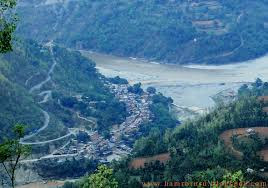 |
| Ridi Bazaar on the banks of Kali Gandaki River |
Ridi is a very holy place in Nepal. Located at the confluence of the small Ridi stream and the larger Kali Gandaki River in Gulmi district, the site is acclaimed far and wide as a pilgrimage site as holy as Benaras. Throughout the ages pilgrims not able to reach faraway Benaras flocked to Ridi for salvation. The famous temple of Rishikesh founded by King Mukunda Sen graces the site. Nearby, only 5 km away on the spur of a hill overlooking the Kali Gandaki River and the famous temple, Juddha decided to build his retirement home at a place called Argali. This is the place the retired Maharajah Juddha had chosen to live the life of a raj-rishi embracing the virtues of abstinence and meditation. Still his mind was not at complete rest.
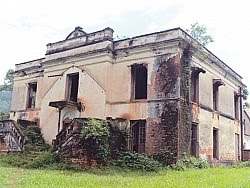 |
| Dilapidated Argali Durbar today |
How soon the bharadars, the courtiers, who were singing praise to the maharajah and extolling his virtues were no longer in sight although Argali was but a few miles to the west from Kathmandu. Power had now passed from the Raj-rishi Maharajah Juddha to the new prime minister Padma Shumsher, his nephew. Padma occupied Singha Durbar. Used to the trappings of absolute power with hordes of people swarming his palace to offer obeisance, it was rather lonely now at Argali admitted the Maharajah to himself. The Durbar was gone. Only his youngest wife Kanchi Maharani was there. Even the children from her had grown up and were living independently in their own bhawans in Kathmandu built for them by the Maharajah. This was his own doing of course reflected Juddha. He had voluntarily resigned from the powerful office of prime minister and the title of Maharajah of Kaski and Lumjung, the only Rana ruler ever to do so. He was the de facto ruler of Nepal for 13 long years like his Rana predecessors had been since 1846 A.D. as the Kings of Nepal were mere figureheads without any political power. And he had given it all up.
He had his innings at the helm and he was proud that he did the nation a great service after the devastating earthquake of 1990 B.S. He had mobilized all resources at his disposal and rebuilt. He had denied foreign aid for reconstruction as this would invite intervention in the internal affairs of Nepal. He had continued the policy of his predecessors in assisting the British government and so during World War II he offered Nepalese troops to fight for them in Burma. He had sent his own sons to the front leading these armies. He started mills and industries in Nepal, banks to finance them and an insurance company to mitigate calamity. He made a zoo in Kathmandu to the delight of the populace. He made innumerable rest houses for pilgrims and renovated temples and monasteries. But there had been failures too he reflected sadly. He had taken out from the Roll of Succession his nephews, sons of his predecessors Maharajah Bir and Bhim from their junior wives. This had created a great friction in the ruling family and destabilized it. These nephews had now funded the nascent democracy movements from their safe havens in Calcutta. These movements for democracy had put him in a corner. He had to sanction the harsh measure of capital punishment meted out to some of the ringleaders of these movements following the clamor from inside his inner ruling circle.
 |
| My father Gen. Kiran with Maharajah Juddha and Pandit Nehru |
It was time now to leave Argali, leave Nepal altogether and seek solace in the Indian Himalayas. The year was 1948 A.D. Weighing his many options he finally decided on Dehra Dun capital of today’s Uttarakhand State of India. These areas belonged to Nepal before the 1816 A.D. Treaty of Sugauly when Nepal had to give up significant territories to British India following a brief war. Places such as Dehra Dun, Nainital, Almora and Garhwal were still home to the Nepalese diaspora. There Juddha would feel at home away from home. Where would he stay though? Prime Minister Pandit Nehru and Home Minister Sardar Vallabh Bhai Patel of India invited Juddha and kindly offered him a temporary residence before he could complete his own abode. He decided to call his son General Kiran Shumsher J. B. Rana from Nepal to help him build one. My father took particular pride in constructing a last repose for my grandfather in retirement at the expansive grounds of 13 Young Road, Dehradun Cantonment. Juddha had entrusted him with the task from among all his seventeen sons, a singular honour for my father. Maharajah Juddha found peace in this new abode and passed away in 1952 A.D. in Dehra Dun. This building today is part of the campus of the Cambrian Hall School founded in 1954 A.D. by Colonel Shashi Shumsher Rana, Maharajah Juddha’s youngest son from his Kanchi Maharani.
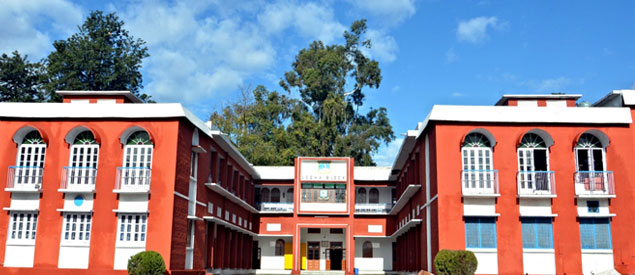 |
| Cambrian Hall School today |
Comments Off on THE MAHARAJAH’S LAST REPOSE
The glorious uncrowning
February 9th, 2016
By Subodh Rana.
The 104 years of Rana Regime of Nepal reviled today as a monolithic juggernaut from without was anything but when viewed closely from within. The struggle for power within the family was as acute as those among the Roman emperors or Mughal rulers. Out of the nine Rana prime ministers only four died while in office, one was assassinated, two were prematurely ousted from office, the last one had to step down to give way to proto-democracy. Only one among the nine actually resigned voluntarily while in office. This is his story.
 |
| Maharajah Juddha Shumsher |
So why did Maharajah Juddha Shumsher Jung Bahadur Rana resign bucking the trend? Was it because he was afraid that he would be ousted like one of his predecessor Maharajah Dev Shumsher? Was he afraid that there was some nefarious plot to assassinate him like his uncle Maharajah Ranauddip Singh? When one makes a decision of such magnitude, there must have been multiple factors influencing him to come to such a decision. Had he not resigned Maharajah Juddha Shumsher J. B. Rana would have been the last Rana prime minister of Nepal if we maintain the trajectory of history as it is and end the Rana regime in 1951 A.D. Juddha passed away peacefully in Dehra Dun in India in 1952 A.D.
One must start investigating by learning who he really was at birth. One of the youngest sons of Commander-in-Chief Dhir Shumsher Jung Bahadur Rana from his morganatic wife Juhar Kumari reportedly from Kangra, Juddha was not born a Roll-wallah, but was added to the Rana nomenclature at the time of his eldest brother Maharajah Bir Shumsher reportedly by a death-bed wish of his father Dhir. It can be surmised that Bir was only too willing to fulfill his father’s wish as, at the same time, he also raised the status of his children from his second Newari wife to the Roll of Succession to the tile of Maharajah of Kaski and Lamjung and Prime Ministership of Nepal. Nearly of the same age Juddha grew up together with his nephews Rudra, Dharma and Pratap, Bir’s children from his second wife.
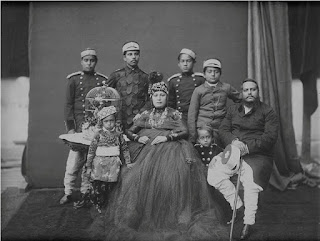 |
| Maharajah Bir with his second wife and children |
Juddha was brought up by his foster mother Maharani Karma Kumari the first wife of his elder brother Dev Shumsher who succeeded Bir as prime minister of Nepal. Juddha paid equal reverence to his foster mother as to his own as testified by the two statues he built for them and placed them at the Jawalakhel Zoo, Nepal’s first and only zoo which was inaugurated by Juddha amidst great fanfare. Juddha knew that karma was very important in guiding one’s destiny and he, like many of his contemporaries, had a fatalistic approach to life and regarded the quest for the hereafter to a greater degree.
Although raised to the status of “A” Class Rana and listed in the Roll of Succession he was one of the youngest in line to the title of Maharajah of Kaski and Lamjung and the post of Prime Minister of Nepal. Perhaps in his younger days he never even thought once that one day he would inherit the title and the post. He could have never known that after Bir, Dev would be removed from his post by his own younger brother Chandra. Chandra Shumsher ruled for 31 years and died in office. His younger brother Bhim succeeded Chandra at an old age and he ruled for only 5 years until he died in office due to natural causes. Juddha succeeded Bhim at the age of 58 and became the next dictator of Nepal.
An ascetic living in the Resunga hills of Gulmi district of western Nepal had once correctly – as it turned out – prophesied that Juddha would one day become the ruler of Nepal, perhaps to disbelief on the part of many, including himself. But his prophesy came true and since then Juddha started to consult Resunga Mahaprabhu frequently and even brought him to Kathmandu near the seat of power. As a young boy I recall the ascetic with white silken skin, piercing eyes and white thinning beard flowing down to his knees doing samadhi meditation in Pashupatinath and my father would occasionally visit him there. Was Juddha tricked into retirement by some treachery of his nephews in cahoots with the ascetic clairvoyant? They took stock aghast of some of the liberalization Juddha had brought to social life and the economy. There is a story that has the ascetic Resunga advising Juddha that he had just one more year to live and so it was better to retire from politics and gain spiritual wealth.
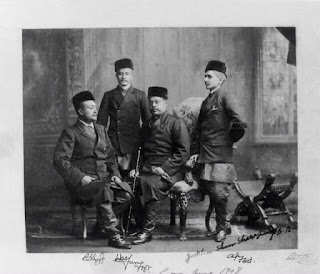 |
| Juddha, seated in centre, with Rudra seated on his right |
One of the first acts of Juddha upon assuming high office was to change the Roll of Succession earlier carried out by Bir and Bhim and take the children of his brothers born out of secondary wives out of the Roll. Did he do this out of his own volition or was it due to intense pressure from his ambitious nephews, the wealthy and powerful sons of Chandra pining for the high office. Juddha removed his second in line Commander-in-Chief Rudra Shumsher, the eldest son of Bir from his second wife from the post and banished him to Palpa. So were the sons of Bhim Shumsher removed from the Roll and banished to various parts of the country, away from Kathmandu, by giving them governorship of far flung lands.
This act is a mystery very hard to unravel. Why did Juddha betray Rudra his childhood friend? Why did he undo the decision taken by the Bhardari Sabha (Privy Council) of Bir his brother who had generously enlisted him Juddha as well in the Roll? Was it due to the pressure from the sons of Chandra Shumher? Did he genuinely think that what he was doing was just and good for the Rana dynasty? Did Juddha repent this decision later and did it play a role in his resignation?
The third angle we need to closely look at is the geopolitics of the time. Since his rule began there was a tremendous movement in India started by Mahatma Gandhi to force the British to give self-rule (swaraj) to India. Many of the politically inclined from Nepal had also gone over to India to support Gandhi in this movement and eventually created political awareness too back home aimed against the dynastic Rana regime, closely linked in their eyes to the British Raj in India. It was during this period of political agitation that some of the ring leaders against Rana rule were charged with sedition and given the death penalty. Four of them have since been celebrated as martyrs after the Rana regime collapsed in Nepal.
 |
| Retired Maharajah Juddha with Pandit Nehru in Dehradun,
my father General Kiran at the left of picture |
Juddha must have known that soon the British would be forced out of India and give India its independence which would in turn spell doom upon the Rana regime. Although he maintained personal relationship with the Indian freedom movement and Pandit Jawaharlal Nehru and other leaders, the trajectory of history would not leave the Rana regime intact. Perhaps he thought that he would resign before the inevitable happened. He took destiny into his own hands and decided that it would be better to voluntarily leave power than to be ignominiously shunted out.
29 November 1945 dawned bright and clear. Maharajah Juddha summoned all the civil and military high ranking officials of Nepal for a special ceremony at Singha Durbar, the official abode of the Rana prime minister of Nepal. This day he would voluntarily hand over the headgear or Sarpech of the Maharajah of Kaski and Lamjung and the post of prime mister to Commander-in-Chief Padma Shumsher Jung Bahadur Rana. He would from then on be known as Rajarishi (Raj-rishi) Maharaj, one who in an act of ultimate glory uncrowned himself and decided to live the life of an ascetic in spiritual quest and penance just like his mentor Resunga Mahabrabhu. At the time he did not know that he would live until 1952 A.D., for another 7 years instead of the one prophesied.
 |
| Maharajah Juddha bidding farewell to his posts and titles |
Comments Off on The glorious uncrowning
An Englishman in the court of Nepal
December 3rd, 2015
By Rana Subodh.
The old Englishman was very fond of Prime Minister Jung Bahadur Rana. He reminisced about how the brash youngster attached to the retinue of Crown Prince Surendra had performed impossible feats the feckless prince commanded of him. He had heard that Jung jumped from the Trishuli bridge on a horse into the raging river below. At another time the prince had demanded that Jung jump into a deep well. The most fabled feat was the daredevil jump from the Dharahara tower built by Prime Minister Bhimsen Thapa to commemorate Nepal’s Pyrrhic victory over East India Company a decade earlier. Jung performed his jump harnessed to two huge umbrellas. Jung had escaped unscathed. Hodgson pondered whether these stories were factually true.
 |
| British Residency in Nepal |
Unfortunately he, Hodgson, had played a hand in the downfall of Prime Minister Bhimsen Thapa and the eclipse of his family including his grand-nephew Jung Bahadur, now Nepal’s strongman. Politics was dirty. Since the opening of the residency in 1816 A.D. a year after the Treaty of Sugauly ended the Anglo-Nepal war, it fell on the British Resident to make sure Nepal was pliable and another misfortune would not occur that could bring renewed clash as some segment of the Nepalese court was still smarting from the bitter defeat. There were those clamoring for revenge. As Assistant Resident to Gardner since 1924 and Resident in Nepal since 1833 A.D. Brian Hodgson had received strict orders from his superiors to make sure the “right” side won in Nepal’s fluid politics.
Prime Minister Bhimsen Thapa was an old man and had held sway over much of Nepalese politics through four decades of some of the most tumultuous period in its history: from the downfall of Damodar Pandey and incarceration of Queen Subarna Prabha to the Regency of Queen Lalit Tripura Sundari and coming of age of King Rajendra Bikram Shah. Smack in between was the disastrous war the expanding Gorkha state fought with the British East India Company. Bhimsen somehow survived this debacle and continued to rule. Hodgson and his masters in Calcutta including Governor-General Auckland were already getting weary of Bhimsen who was still the head of a very large standing army.
Brian Houghton Hodgson was born in 1801, second of seven siblings, and lived in England 18 years of his life before arriving in India employed by the East India Company. He learned Persian to make himself useful to his employers as it was the lingua franca among the rulers of the indigenous Indian states then. After postings from Calcutta to Kumaon and Garhwal, erstwhile Nepalese provinces ceded after the Treaty of Sugauly to British India, Hodgson first arrived in Nepal to take up the post of post-master and then got promoted as assistant resident in Kathmandu. Under the treaty of Sugauly following the Anglo-Nepalese War Nepal was obliged to open a British Residency in Kathmandu. Hodgson felt like he was more of a prisoner than an emissary as he was confined to live in the residency and his every move carefully monitored by Bhimsen. He had to take a special permission to visit Kakani or Godavari in the valley foothills in pursuit of his hobby of documenting the many ethnic groups of Nepal and studying its flora and fauna. He decided to learn how to read and write Nepali and speak Newari too, the tongue of the indigenous people of Kathmandu valley.
King Rajendra Bikram Shah came of age in 1832 A.D. the same year his step grandmother Regent Queen Lalit Tripura Sundari passed away. He was seen as a friend of British India and always maintained a cordial relationship with Resident Brian Hodgson. By 1837 he had consolidated power and stripped Bhimsen Thapa and his nephew Mathabir Singh Thapa of their military command. This was what the East India Company wanted as threat to armed conflict was ever present under those leaders. Shortly thereafter the youngest baby of senior queen Samrajya Luxmi died and Bhimsen was falsely implicated in poisoning the prince. He was imprisoned and had to undergo untold of humiliation and privations. Mathabir exiled himself to the court of Maharajah Ranjit Singh of the Punjab. His entire family was in disarray now including the fortunes of those dependent on him such as his grand-nephew Jung Bahadur Rana. Bhimsen had finally committed suicide in prison.
 |
| Lord Auckland |
Reflecting on those tumultuous years at the court in Kathmandu Hodgson now regretted that he had not stepped in to save Bhimsen Thapa. He had received smuggled letters from Bhimsen himself from prison to help him by proclaiming his innocence to King Rajendra but Hodgson had not acted upon them. One of the reasons was that by 1840 A.D. Lord Auckland had asked him to stay clear of the internal politics of Nepal as he believed that as long as the military forces of East India Company were superior, the British need not fear Nepal. Notwithstanding this edict Hodgson had sent his superiors request to intercede on behalf of Bhimsen but it was too late now. When the news of Bhimsen’s suicide was delivered to the residency, Hodgson’s eyes had welled up with tears of sympathy for the innocent, unfortunate man.
All that was behind Hodgson now. He had been removed from his post in Kathmandu by the new Governor-General Lord Ellenborough over his unfortunate decision to delay delivery of a letter from Calcutta to the king as he felt it would weaken the British position. It had come at a most inappropriate time too when his Kashmiri wife Meharunnisha was giving birth to their third child. The Raki Bazaar in Asantole in Kathmandu sells bangles and other ornaments and Kashmiri Muslims were the vendors there from the time of the Malla kings. He had fallen in love with a young girl from this community and taken her as his bride. Piqued, he had resigned from Company employment and headed back home to England in 1844 A.D.
 |
| Lord Ellenborough |
After a year of rest and family visits Hodgson returned to India. As the government did not allow him to set foot in Nepal even in a private capacity, he decided to retire in Darjeeling to pursue his interests in the Himalayas. It was here that news travelled to Hodgson on the Kot Massacre of 1846 A.D. and emergence of General Jung Bahadur Rana as the new strongman. When leaving Nepal Hodgson had sensed that something cataclysmic would happen there soon with a power struggle taking place among the ineffectual king, an ambitious junior queen Rajya Luxmi Devi, an excessively reckless Crown Prince Surendra and their scheming courtiers.
Prime Minister Jung Bahadur Rana needed someone he could count on to advocate on his behalf with British India. He did not know the new Resident Henry Lawrence well enough. Hodgson was the person Jung could rely on due to his in-depth knowledge of Nepal. Hodgson was now living in Darjeeling and pursuing his study on Himalayan anthropology, ethnology and natural history as a serious scholar, far away from the vicissitudes of Kathmandu politics. Hodgson congratulated Jung and promised assistance. Jung was delighted. His first gesture of friendship was to include the son of Hodgson in his retinue during his epochal visit to England at the invitation of Queen Victoria in 1850 A.D. He personally presented Henry to the queen for which Hodgson was forever grateful.
 |
| Hodgson’s bust in Asiatic Society,
Calcutta |
Thereafter the bond between the Englishman and Nepal’s ruler was firmly cemented. Hodgson looked after Jung’s daughter Badan Kumari and his son-in-law Gajraj Singh Thapa when they went to study tea gardening. They were the pioneers of the tea industry in Nepal. During the Indian Mutiny it was Hodgson who impressed upon the hard-pressed yet unsure Governor-General Lord Canning to accept Nepal’s aid in fighting the mutineers in Lucknow. Prime Minister Jung Bahadur wanted to show gratitude to Britain for its friendship and good behaviour shown towards Nepal. Jung Bahadur personally led a troop of 9,000 Gurkha soldiers to the door of Lucknow. Shortly thereafter Hodgson decided to return to England as his newly married English wife Anne Scott was of poor health and could not take to the Indian climate. Even from faraway England Hodgson kept in touch with Jung Bahadur and gave him advice when solicited. Brian Hodsgon outlived his protege and passed away in 1894 A.D. in London.
Comments Off on An Englishman in the court of Nepal
Symbol of Nepalese Nationhood
October 17th, 2015By Subodh Ranah.
 |
| Dhaka Topi |
It was at St. Xavier’s Godavari School that I first got acquainted with the Nepali state’s aspirations to nationalism. Ironically it was our mainly American Jesuit priests who mandated that on Sundays we could speak only Nepali and wear Daura Suruwal (also called Labeda Suruwal in more refined circles) our national dress. I really do not know where this idea originated but we all accepted it, at first with awkwardness bordering on trepidation, but in time it became de riguer. Imagine suddenly speaking to friends in Nepali when we had spent already a few years together in school speaking to one another only in English! Instead of the white trousers with light blue shirt and tie emblazoned with the school logo now we had to wear the funny looking dress, perhaps for the very first time for some of us! The school knew that giving a good education in various disciplines wasn’t nearly enough without a dose of nationalism to create responsible and enlightened future citizens. The daura suruwal was soon worn with great élan by us the students and often times by the faculty too! Eventually the ethnic diversity of the school body converged into Nepali nationhood in a proud display of our national dress capped by a Dhaka topi. Intrinsically we knew that we were all Nepalis whether we hailed from the east or west, north or south.
 |
| Wedding Daura Suruwal |
Outside the school King Mahendra’s Panchayat polity propounded a system of guided democracy with sovereignty vested in a Hindu monarch who embodied the Nepali statehood of a diverse nation of four races and 36 ethnic groups. Multi-party democracy we were taught would force the nation asunder. From the time of the unification of Nepal by King Mahendra’s forebear King Prithivi Narayan Shah the language of the Khas people had developed into the lingua franca of Nepal called Nepali, just as their dress the daura suruwal and gunyo cholo for women evolved into the national dress of Nepal. From 1960 on it became mandatory for government civil servants to wear it during office hours.
 |
| Ottoman Empire Bosnian |
One often wonders where the daura suruwal originated from. If one looks at the national dress of the Greeks, to those in the Caucasus and eventually to Persia we definitely see the proto-daura suruwal: the long gown worn over tight leggings. The Mughals of India too had similar dresses no doubt brought from their ancestral home in Central Asia if we were to glean from the many portraits of the Mughal emperors from Akbar to Aurangzeb. When the first wave of the displaced Hindu princelings and their cohorts made their way to the Himalayan mountains fleeing from the often draconian zeal of the Mughal rulers to convert them to Islam, these dresses made way into the mountains of Nepal too. Much like the tongues, rituals, manners and mores of the Hindu states of India these dresses slowly replaced the costumes of the native tribes of Mongoloid and Tibeto-Burmese descent in the Nepalese hills. During this period too the daura suruwal made its foray into Kathmandu Valley. One can see early pictures of the Newars of Kathmandu wearing the Jama gown.
 |
| Maharajah Bhim Shumsher |
How did religion come into play to popularize this dress as divinely ordained for us Hindus? The daura or the gown has symbolic 8 strings to securely tie both ends of the gown after wrapping it around the body. The figure eight in Nepalese mythology is symbolic of the Asta-matrika or eight mother goddesses offering us protection and longevity. The closed neckline it is believed symbolizes the mythical serpent coiled around the neck of Lord Shiva.
 |
| Jung Bahadur Rana |
The daura suruwal further evolved when Nepal started to interact with British India. It is said that when Prime Minister Jung Bahadur Rana made his official visit to England in 1850 A.D. he found it too cold to move about without wearing the European waist coat and jacket as fashionable then on top of the daura suruwal and covering his head with either his bejewelled coronet on state occasions or at regular times the Dhaka cap, a head cover made from the special cotton weave imported from Eastern Bengal during Jung’s time. He brought back with his retinue a new fashion to the court of Nepal that was to soon become a symbol of Nepalese nationhood and which stood distinctly apart from his contemporaries’ courts in India and China. Not until Nepal opened up to the outside world after the fall of the Rana oligarchy in 1951 A.D. would this tradition of our national costume change.
Nepalese youth started aping western dress codes after the exposure to early tourists of the sixties and the ubiquitous hippies of the early seventies. Nepal was no different to the rest of the world in this respect where traditional costumes have been replaced by the more comfortable and casual shirts and trousers. In cities and towns across Nepal Daura Suruwal is now mostly confined to festive occasions, for wedding receptions and the all-important Dashain Tika when families gather together for blessing from the elders.
Will the Daura Suruwal still retain its pride of place in the newly federated Nepal? I recall the first vice president of the new Republic Paramananda Jha taking his oath of office in Hindi wearing his Madhesi lungi and was promptly ridiculed and, amidst street protests, forced by Parliament to take a second valid oath in Nepali wearing a Daura Suruwal. If the present state of affairs in the Terai region of Nepal is any indication, in future only the hill people may own this cultural heritage. However, today the Daura Suruwal has taken a new meaning outside the borders of Nepal where Nepalese nationalists in Indian Darjeeling and Sikkim proudly wear their heritage and aspire to nationhood. Quid pro quo.
 |
| Me and my Labeda Suruwal |
Comments Off on Symbol of Nepalese Nationhood
A divine test
July 5th, 2015
By Subodh Rana.
Elders in the family passed away one after another each time bringing the title of Maharajah of Kaski and Lamjung and the coveted post of prime minister of Nepal closer and closer to the youngest legitimate brother, a ‘roll wallah’, General Juddha Shumsher J. B. Rana. He had served his elder brothers in various military capacities: as Major General during the time of Bir Shumsher and Dev Shumsher, as Commanding General of the various regions of Nepal during the time of Chandra Shumsher and finally as the Commander-in-Chief of the Nepalese Army during the time of Bhim Shumsher. All the siblings elder to him besides those who got to be prime ministers – those in the roll of succession – Rana Shumsher, Fatteh Shumsher, Lalit Shumsher and Jit Shumsher were now dead. Providence smiled upon Juddha.
 |
| Prime Minister Bhim Shumsher and Commander-in-Chief Juddha to his right |
Bhim Shumsher was an old man of 64 years of age when he succeeded his elder brother Chandra Shumsher to the title of Maharajah of Kaski and Lamjung and the post of prime minister of Nepal in November 1929 A.D. He was, in fact, the oldest Rana prime minister to take this hereditary post. He would rule for only 3 years and die on 1st September 1932 A.D. As per the law of succession Commander-in-Chief Juddha Shumsher was elevated to the post of Prime Minister and received the hereditary title of Maharajah of Kaski and Lamjung. At 57 years of age he was going to be more energetic than Bhim it was hoped against the backdrop of the changing dynamics of the British Raj in India.
Mahatma Gandhi had started his Satyagraha or Civil Disobedience campaign already in 1930 A.D. with his march to the sea to make salt out of sea water in contravention of the British monopoly on salt trade. In 1931 the British had relented and Gandhi had embarked on the London Conference as the sole representative of Indian National Congress Party. For keen observers of the time the writing was already on the wall that the British Raj had to make way for some form of home rule sooner than later. As Juddha took the post of prime minister he realized that he would have to not only deal with the Viceroy and his agents but also with the Indian freedom fighters to save the dynastic rule of the Rana family in Nepal. Preoccupied with politics Juddha least expected the bomb-shell that would rattle his country and test his mettle to govern: the Great Earthquake of 1934 A.D.
Winter in Kathmandu Valley is cold and the Maharajah and his immediate family, as was common practice among the rulers of Nepal, had gone on a hunting trip in the warmer climes of the Terai. Suklaphanta region of the Mahakali district of Nepal is famous for wildlife unique to the region and not found elsewhere, the prized black buck or krisnasar antelope. Juddha Shumsher was a hunting aficionado and regaled at every opportunity he could manage to take a few weeks off from the daily chores of administration of the country and relax in the countryside. His entourage had prepared for the Maghe Sankranti or the first day of the month of Magh (mid January) an important festival date in the Nepalese calendar the prerequisite diet for the occasion – ghiu, chaku (unpurified butter and molasses) and sweet potato to ward off the winter cold. Juddha did not indulge in alcoholic beverages or smoking opiate as a pastime, however having a sumptuous feast for lunch was a habit he had acquired from his youth. His idea of la dolce vita consisted of a meal displaying the proverbial 84 assorted dishes or chaurasi byanjan of legend. He did not touch them all but it was considered auspicious for the rulers to partake, a divine blessing from the Gods.
The second day of the new month was cold and wet and Juddha prepared for another meal after the daily religious rituals. He was soon returning to Kathmandu and there were many things in the state administration that was pending. He must set them right after the festival. He recollected how hard a time his predecessor and brother Bhim gave him to the point he had nearly resigned from the post of Commander-in-Chief of the Army. His honest suggestions would always fall on deaf ears and instead the elder brother had a habit of bullying him, poking fun at him. The time had now come to set things right. His thoughts were sent asunder by a deep rumbling emanating from the ground, it sounded like thunder peal but it was not from the sky. And then the grounds shook. Juddha realized that it was an earthquake, a massive one. He caught hold of the supporting pole of his tent to steady himself. He had heard stories of how a massive earthquake had hit Nepal in 1833 A.D. and how the 2 towers built by Prime Minister Bhimsen Thapa in Kathmandu had crumbled like houses of cards. Only one was rebuilt since then and he wondered whether it would survive this one.
Maharajah Juddha returned to the capital posthaste. He had decided to appoint the young Major General Brahma Shumsher Rana as his point man for all relief and reconstruction works. The second son of General Baber Shumsher one of the senior Ranas in the nomenclatura, Brahma was a very son-of-the-soil type of a person and best suited for this most challenging job. Brahma was an early proponent of Gharelu Ilam and Taleem and was convinced that cottage industry was the new equation that could change the dynamics of Nepal bringing a manufacturing base to a largely agrarian society. He had closely followed the Khadi Movement of Mahatma Gandhi promoting handwoven and hand-spun cloth for India’s use not relying on expensive imports. Brahma was one of the few Rana of the time who publicly wore indigenous clothes. He would command respect of the masses Juddha was confident.
 |
| Maharajah Juddha addresses the nation from Khariko Bot |
Maharaja Juddha upon returning to the capital addressed the nation from the Khariko Bot ficus tree platform in Tundikhel, the vast open space in the city, that had already started to transform into a tent city. His address was a passionate testament to his personal involvement in the relief and reconstruction works that needed to be launched. He vowed to give low interest credit to the victims of the earthquake which was later converted to grants. He instructed his armed forces to assist in the rebuilding of the nation. He warned civil servants from misappropriating public funds putting the fear of capital punishment on those found guilty. Juddha vowed to go it all alone without seeking any foreign governmental and non-governmental assistance from the British Raj in India or elsewhere. Nepal, in four years time, had achieved his vision and Juddha once again gave his speech from the same Khariko Bot informing the nation that all was now well. Dharahara Tower the symbol of national independence Bhimsen Thapa built following the conflict with the British Raj was again standing tall. Nepal had passed a divine test with flying colours.
Comments Off on A divine test




